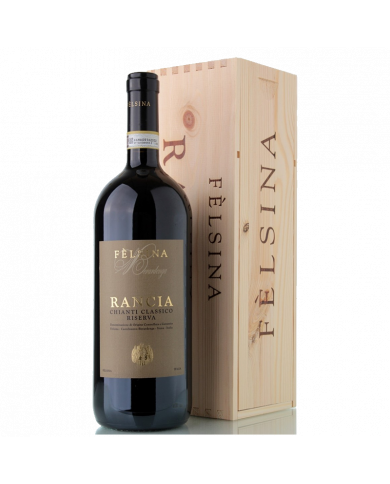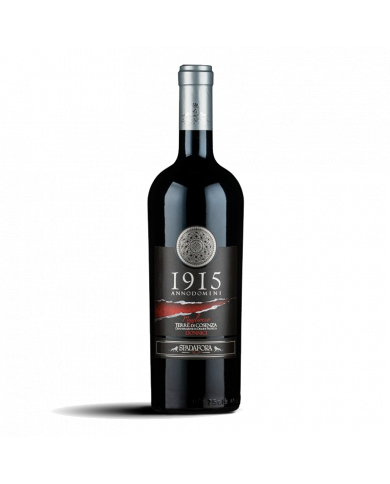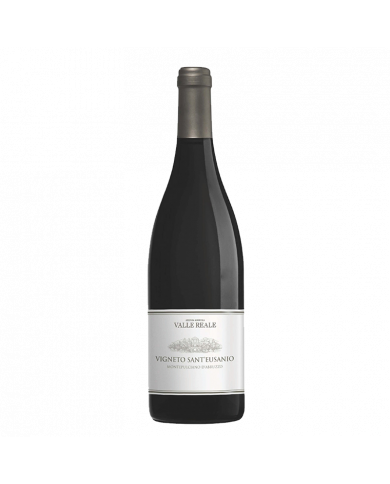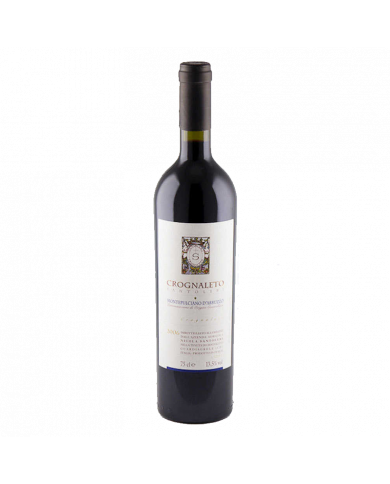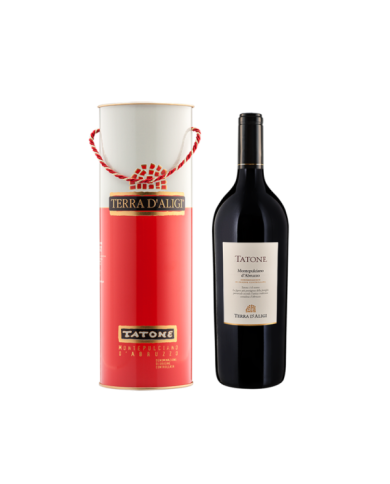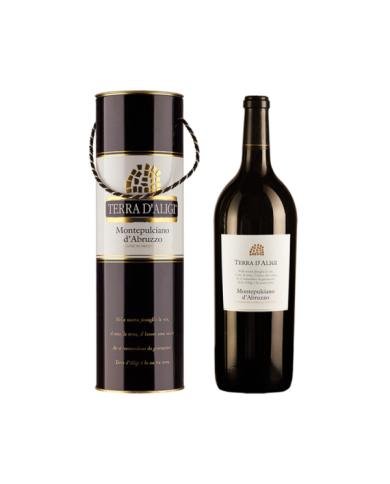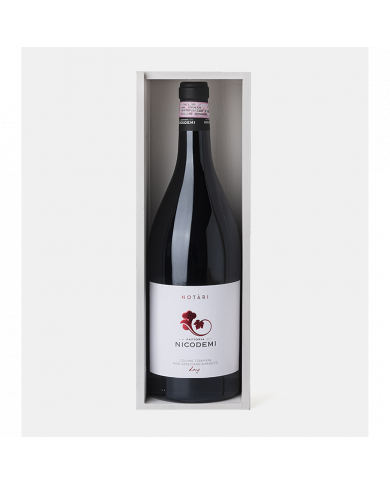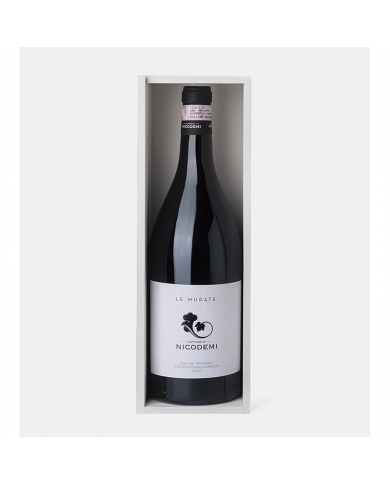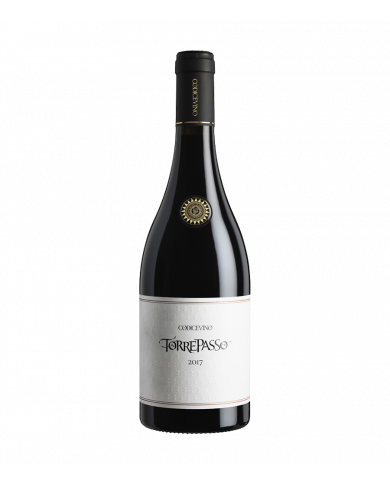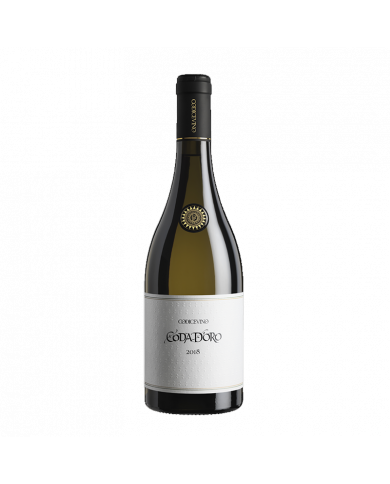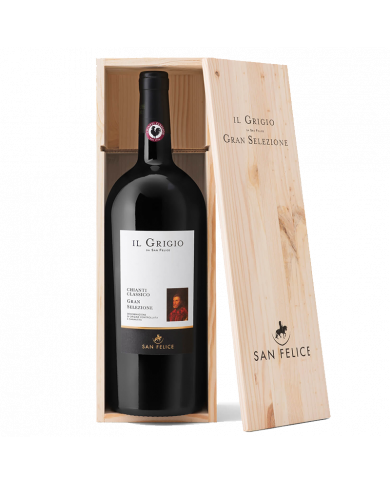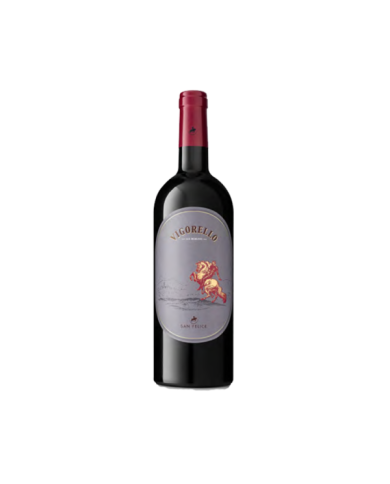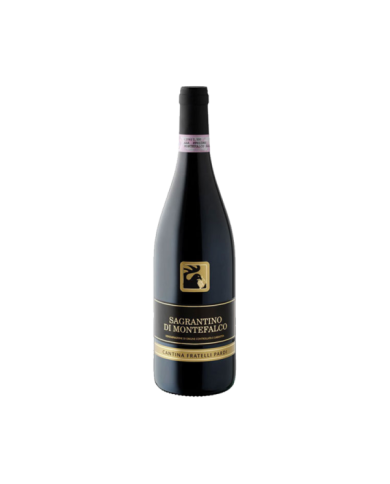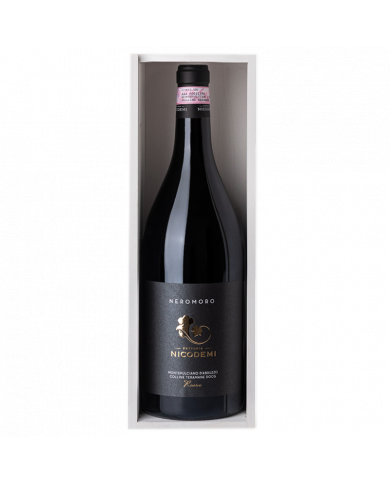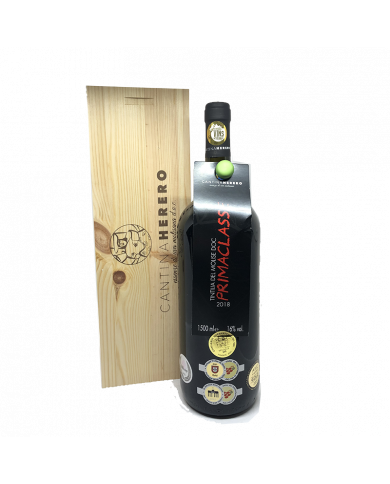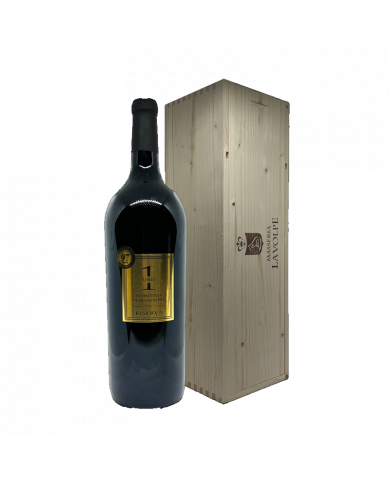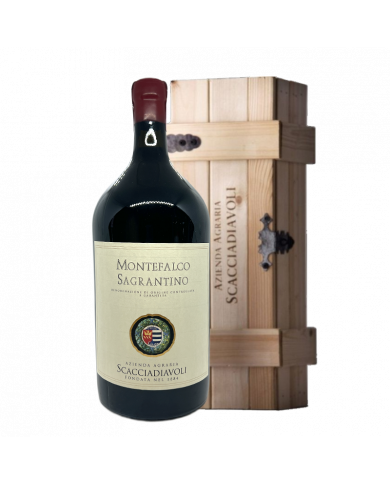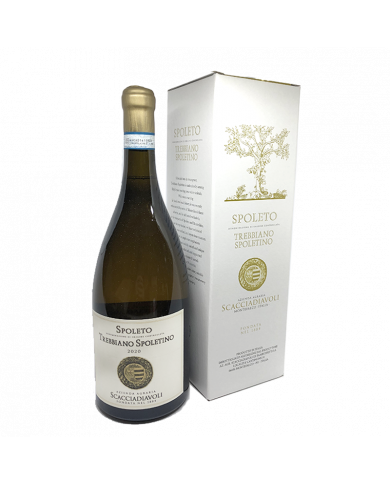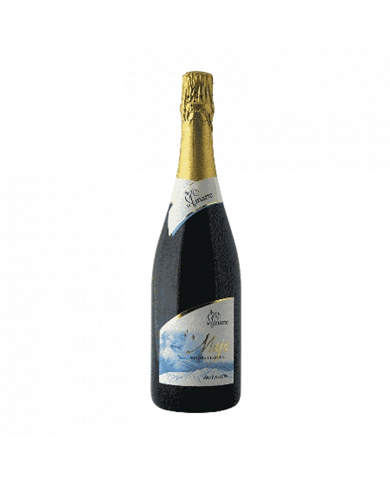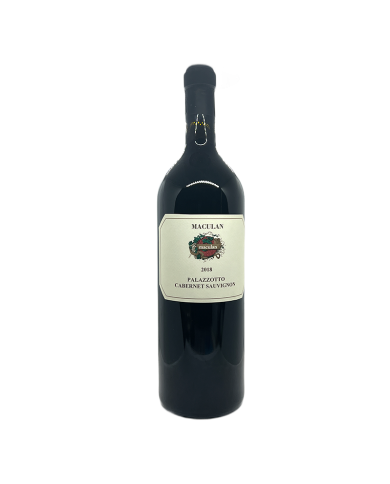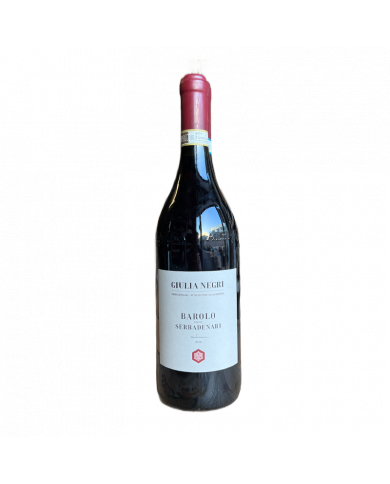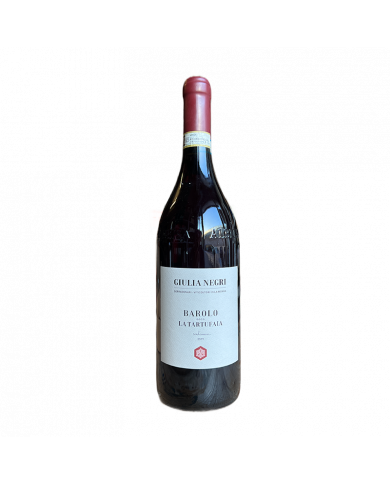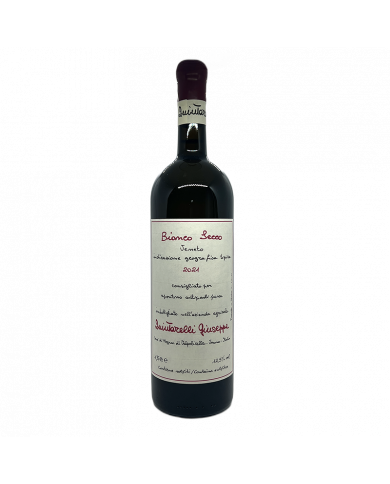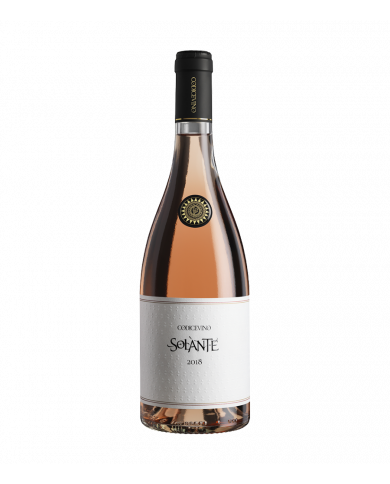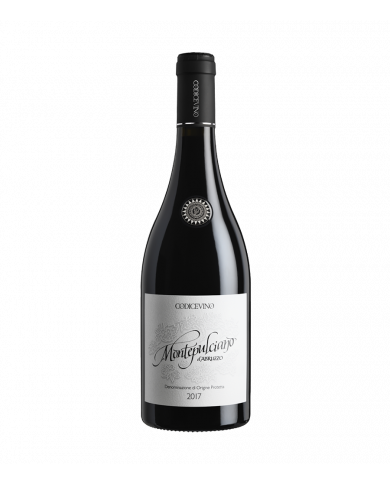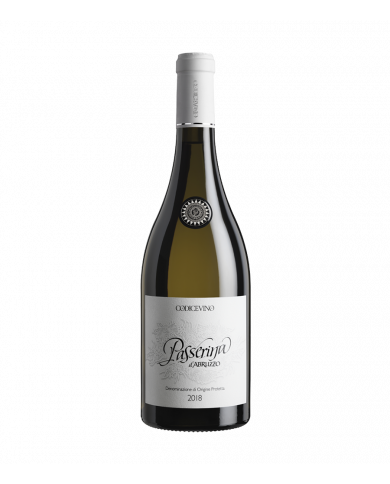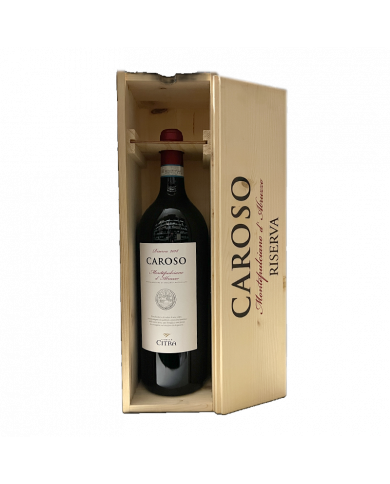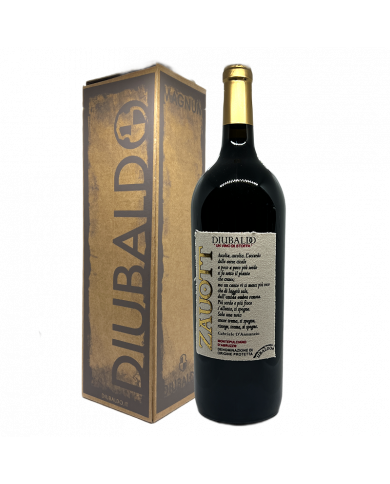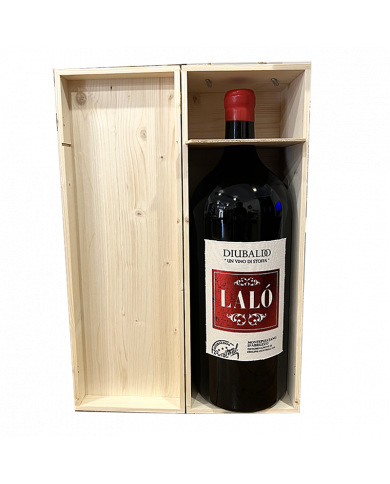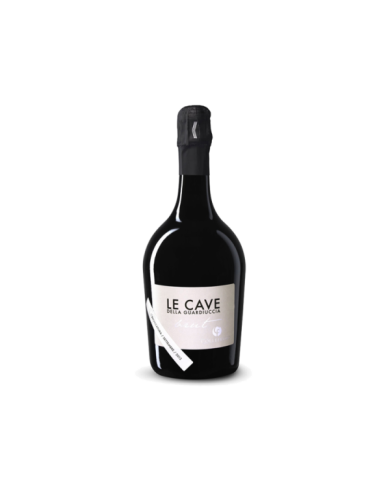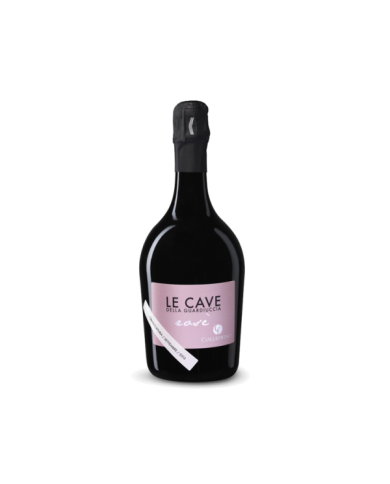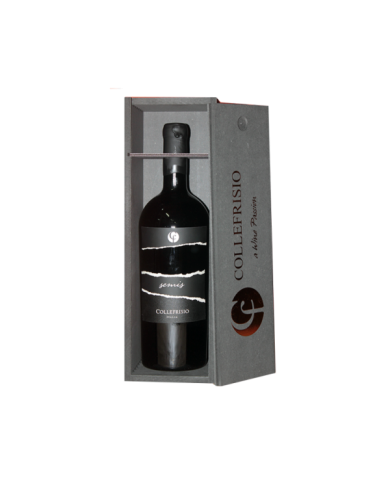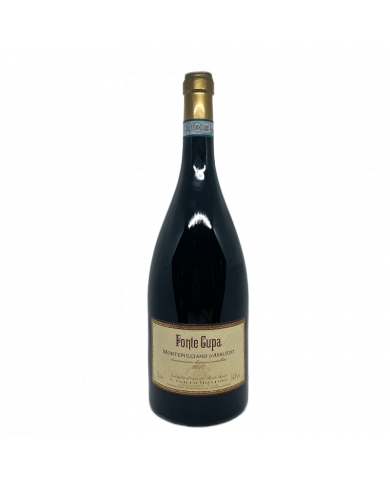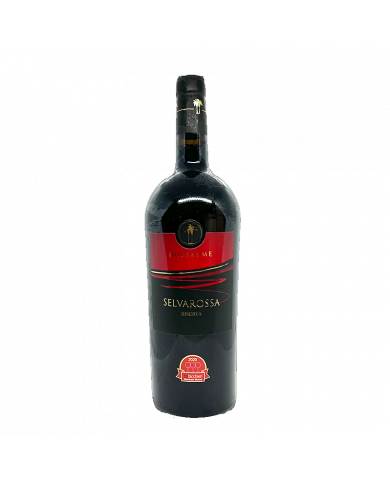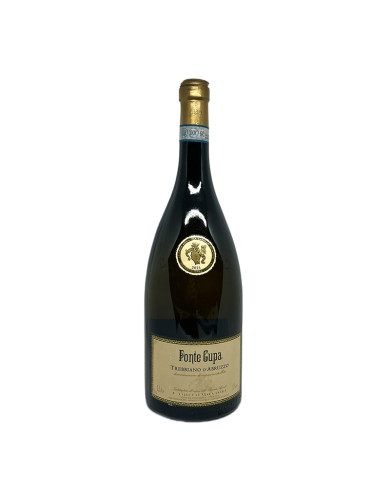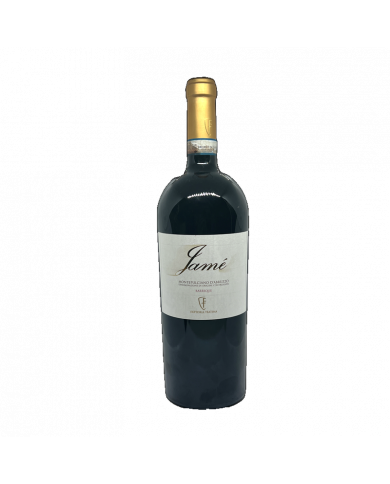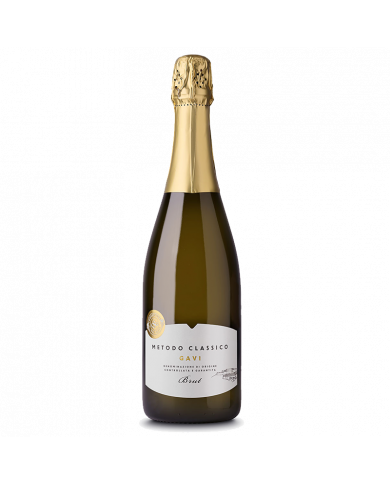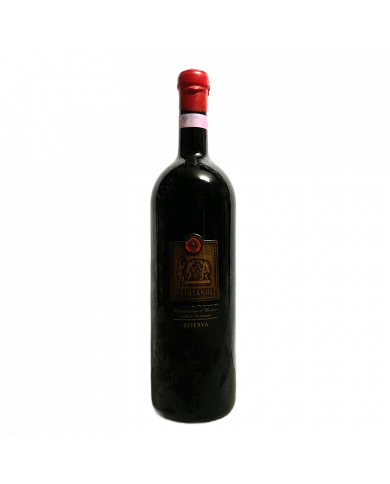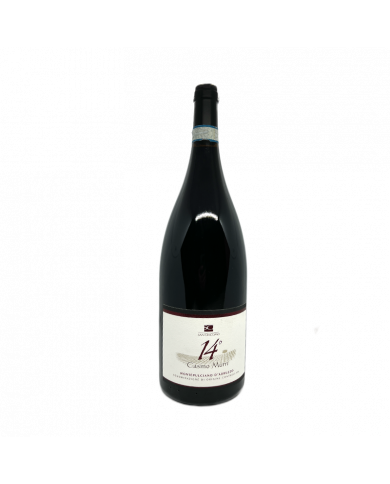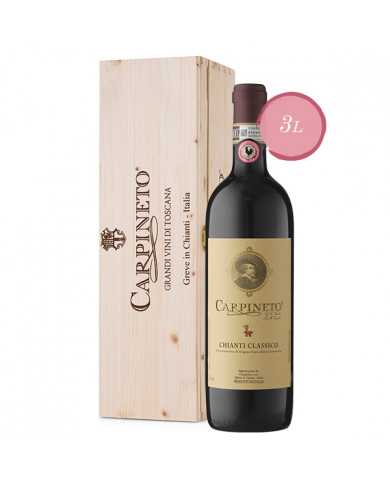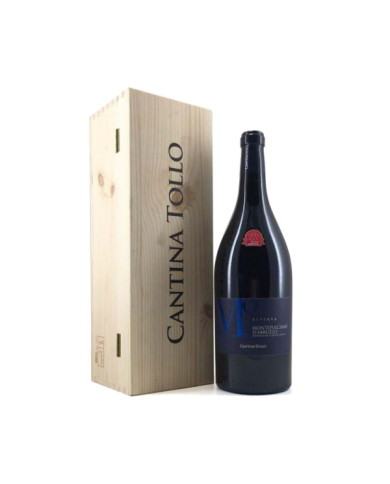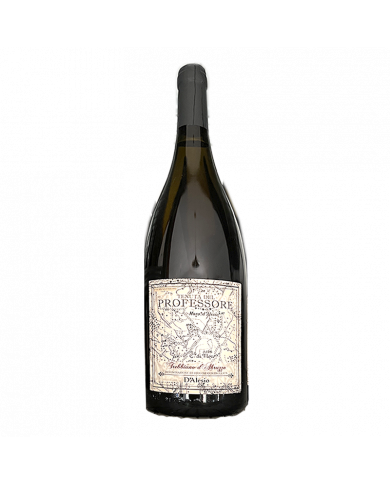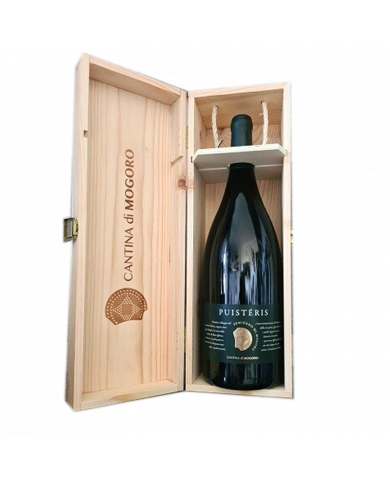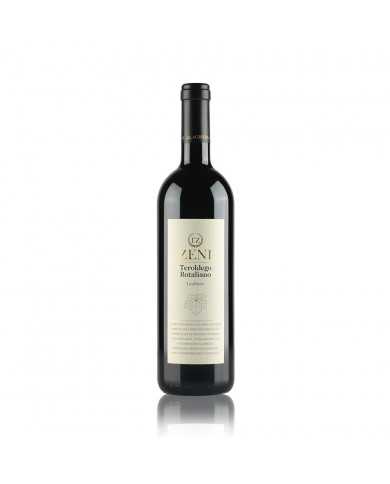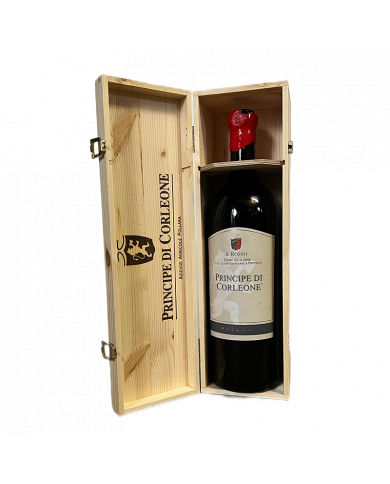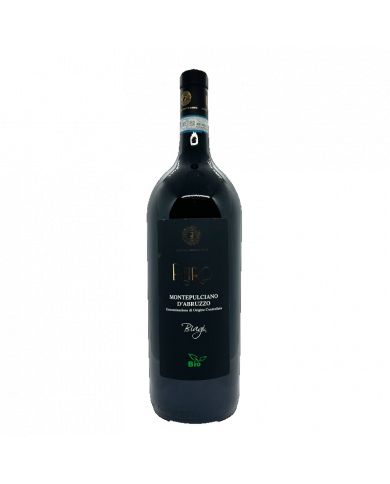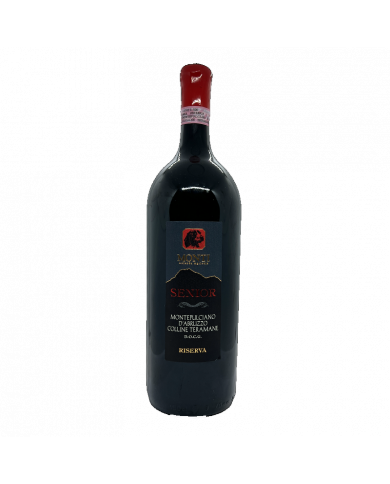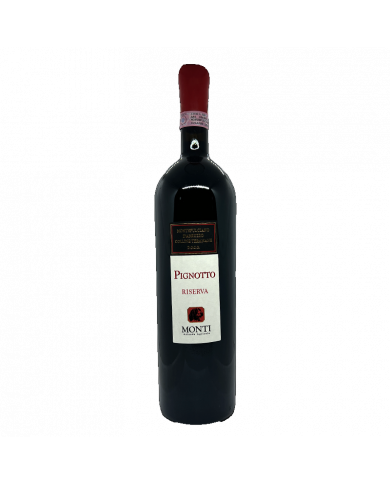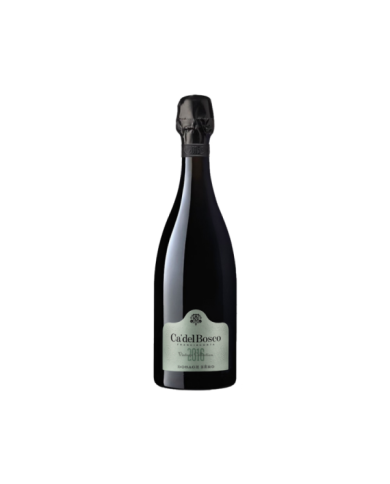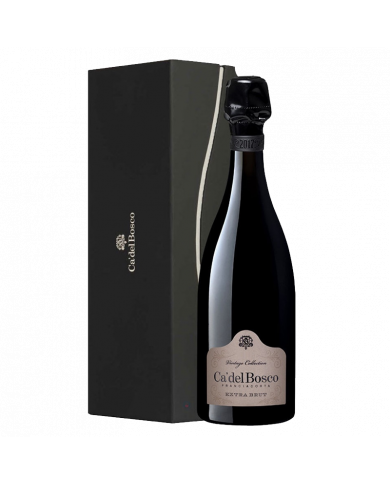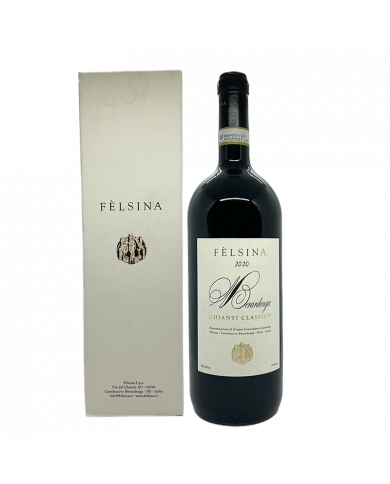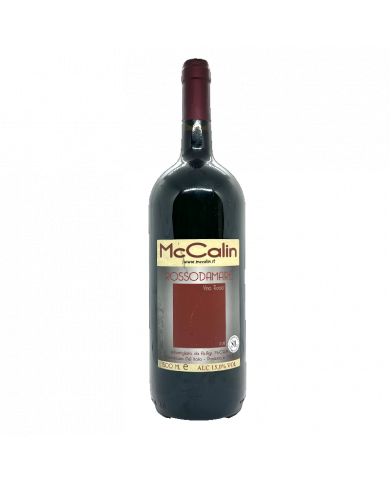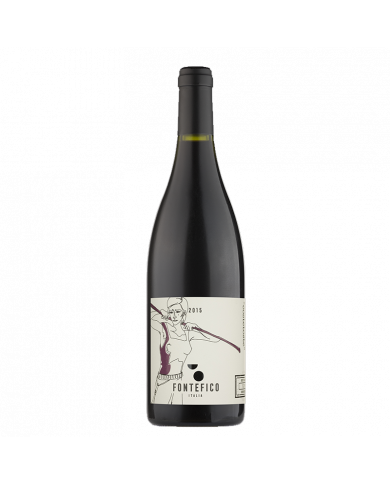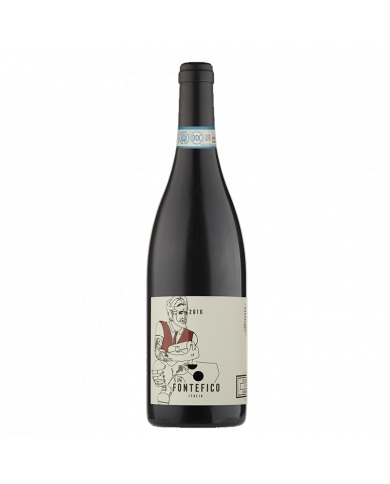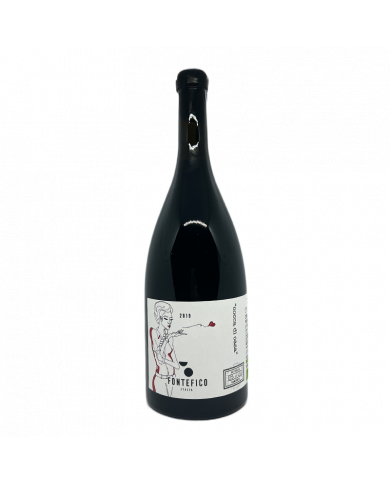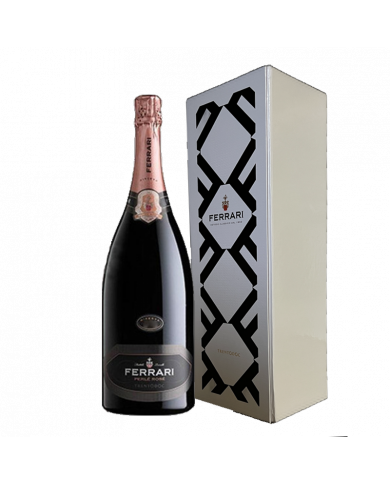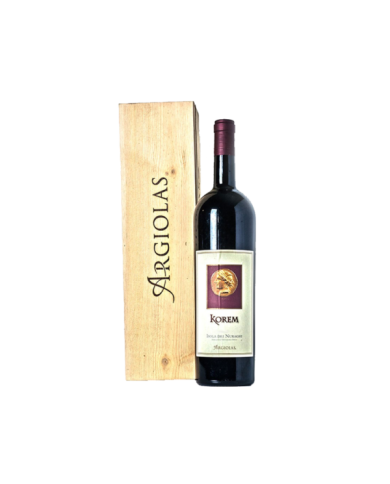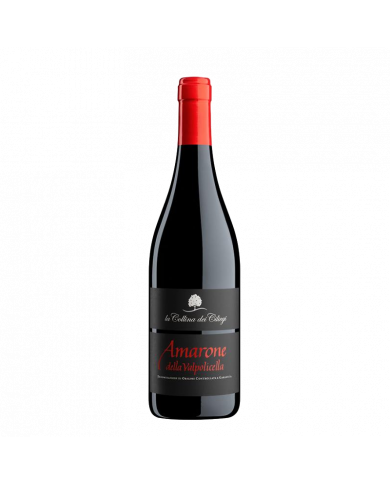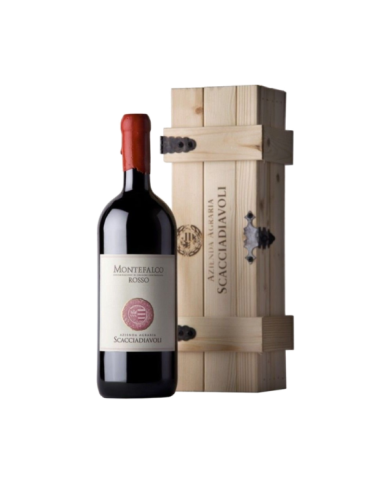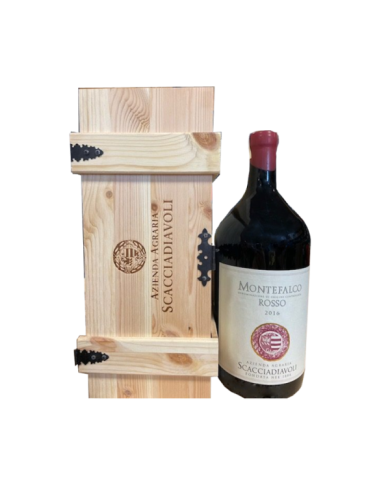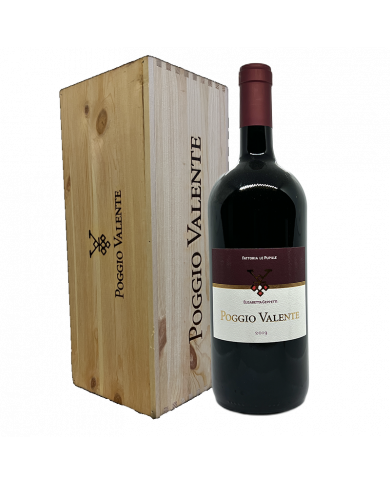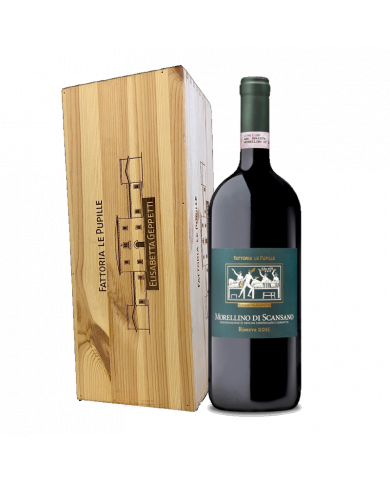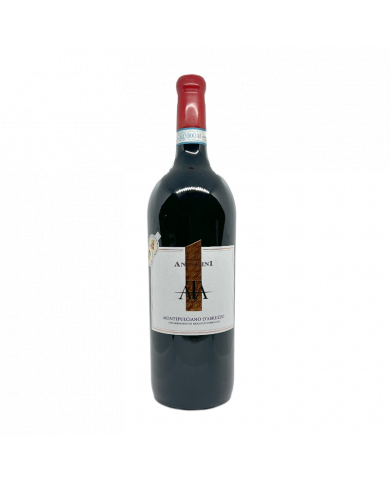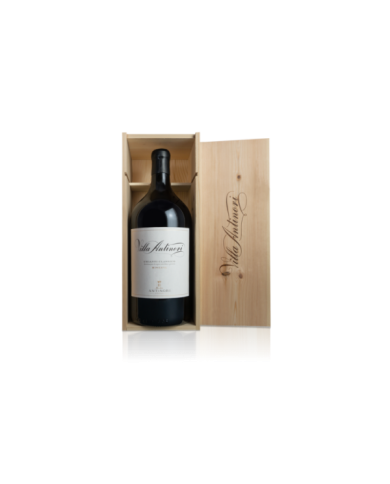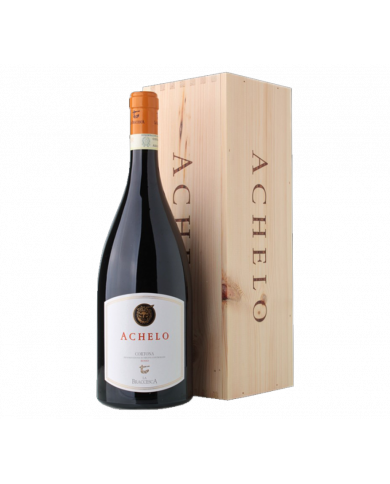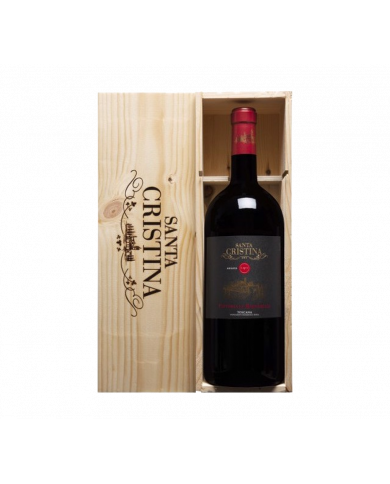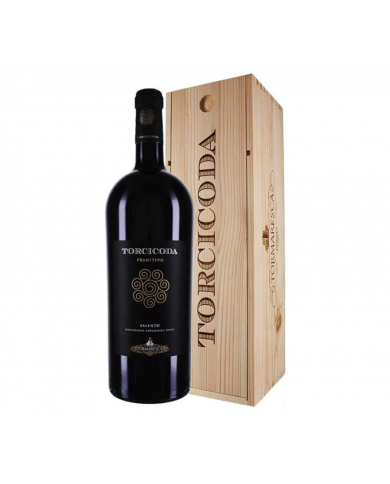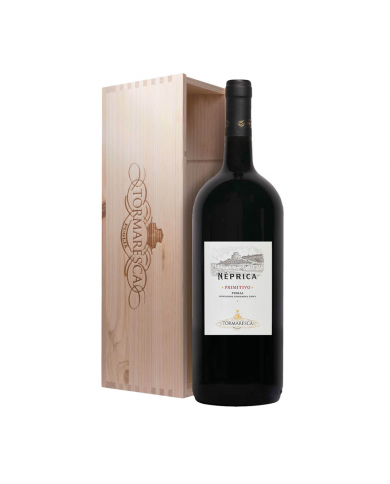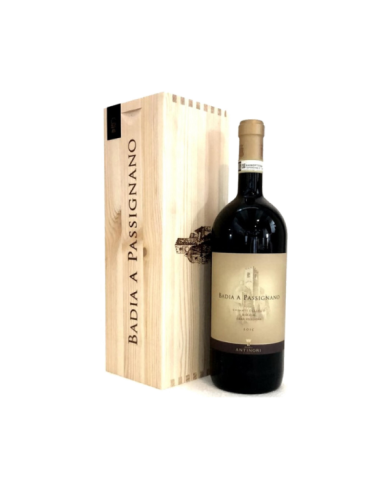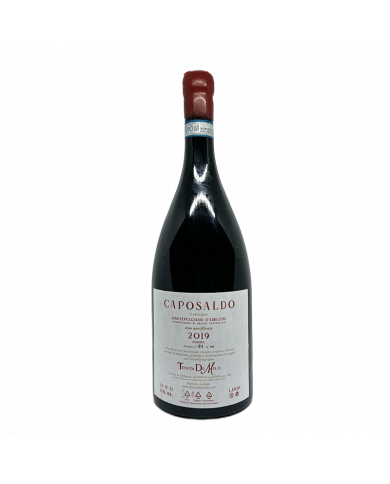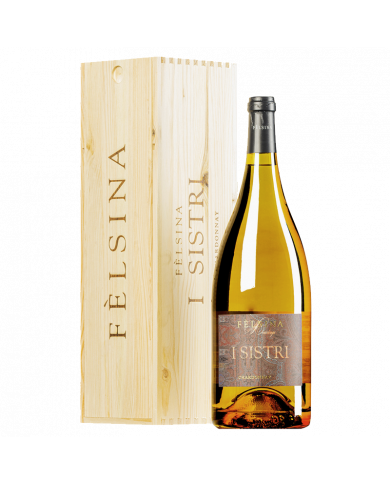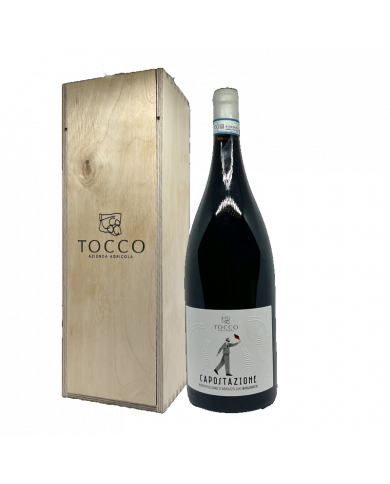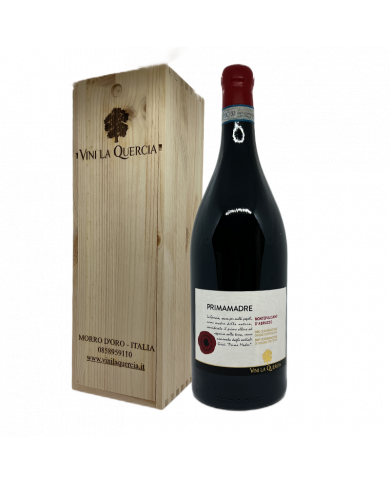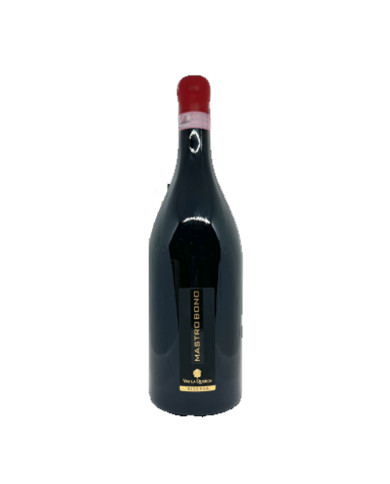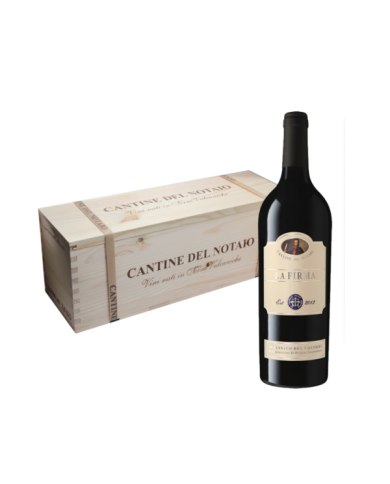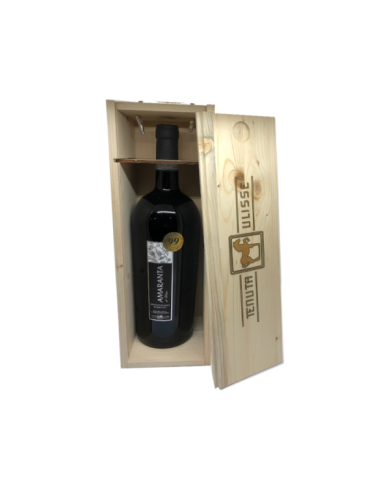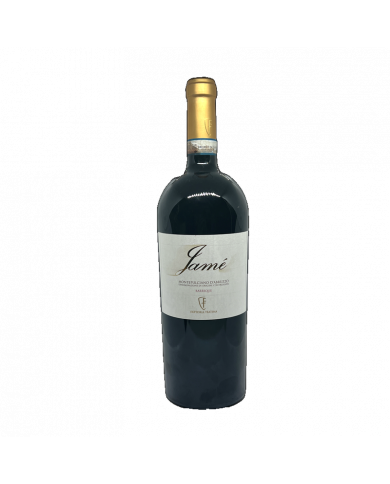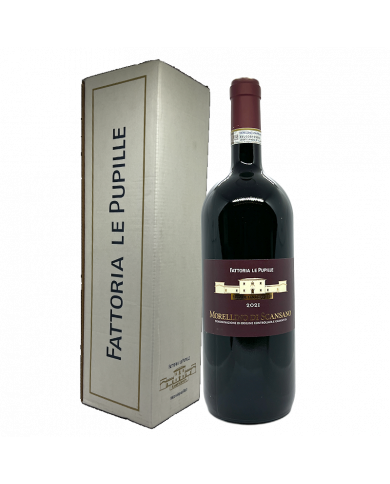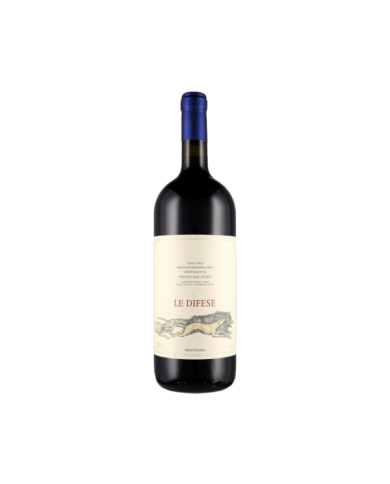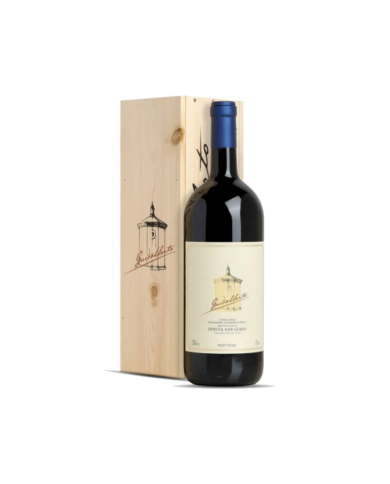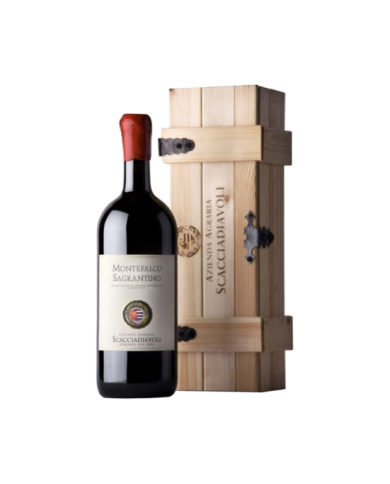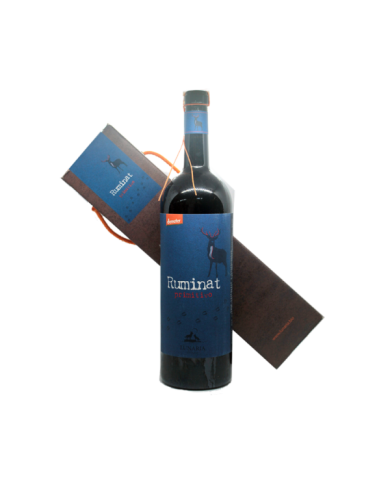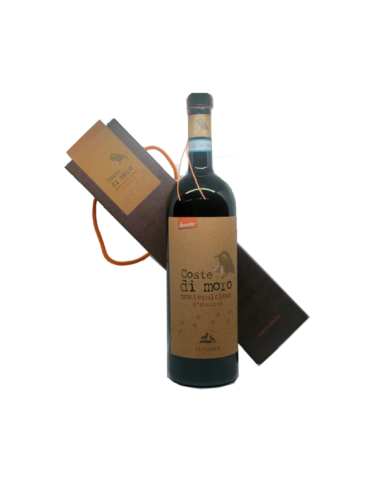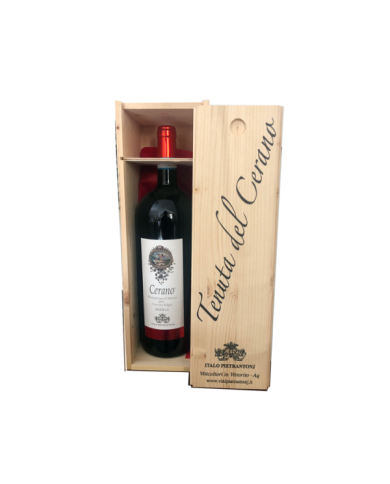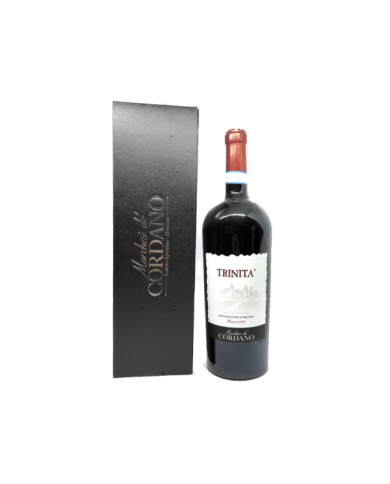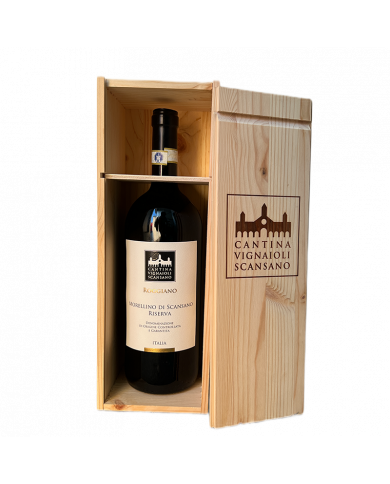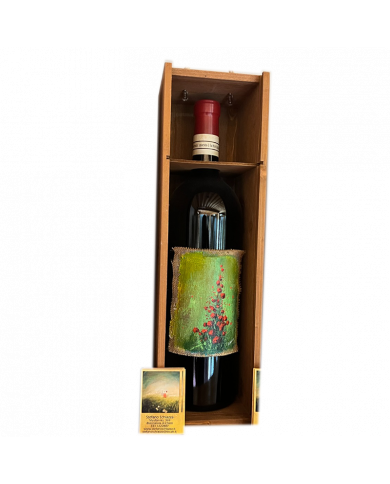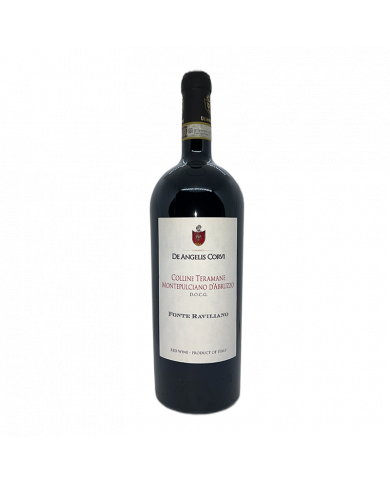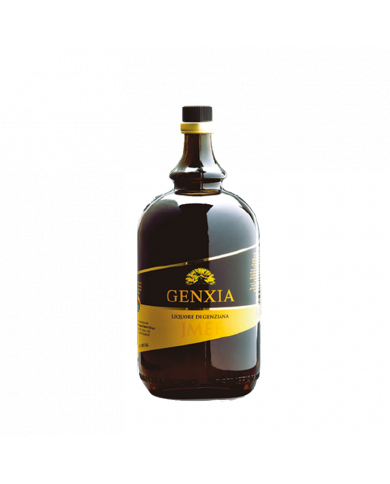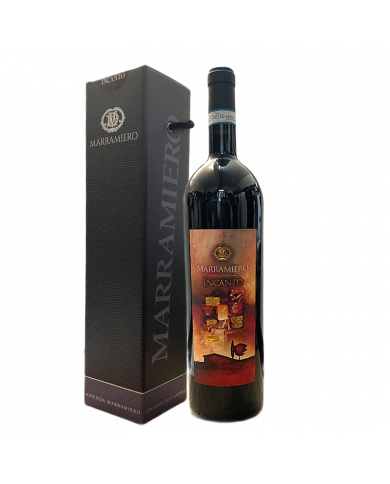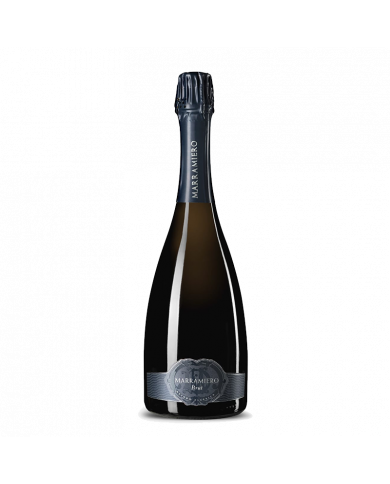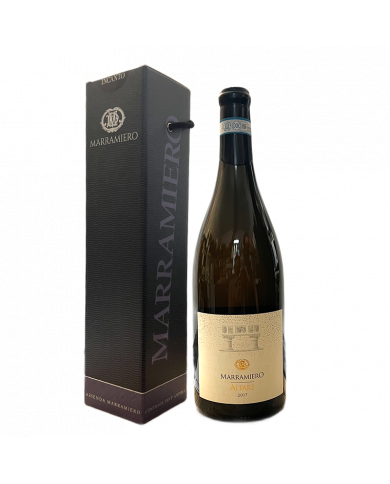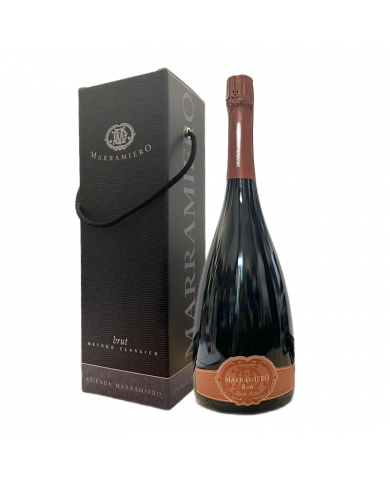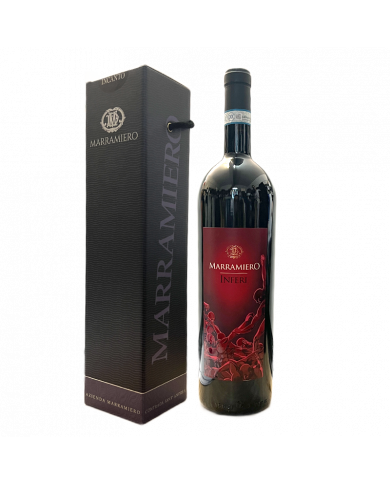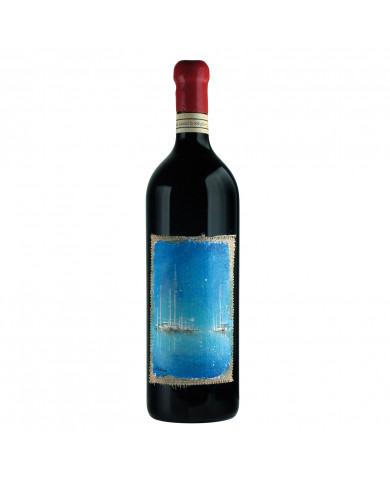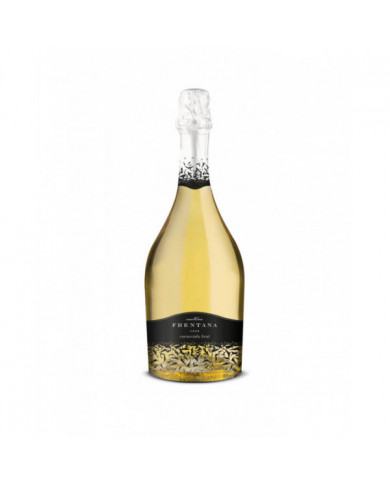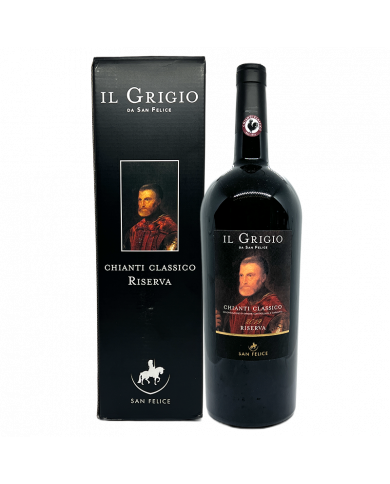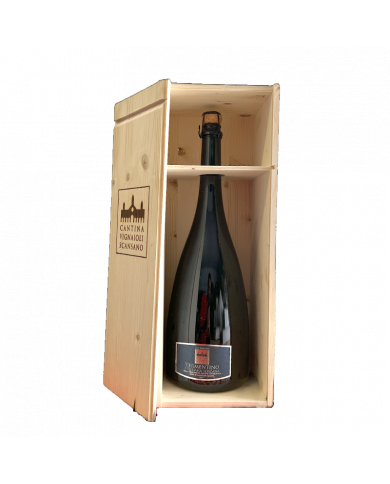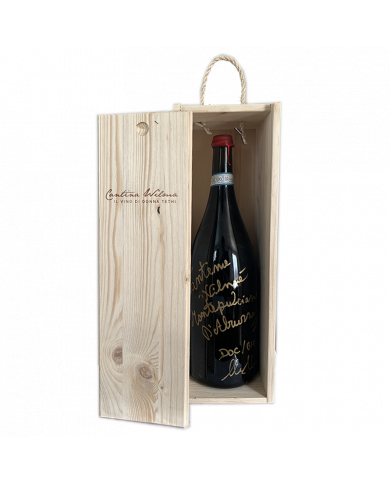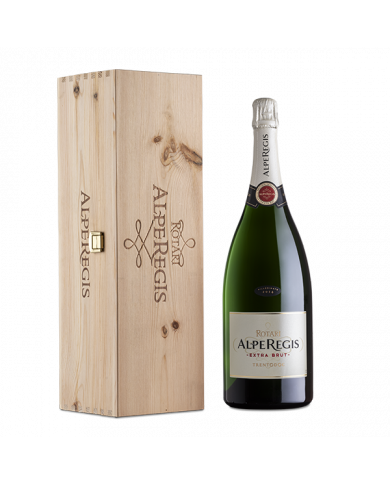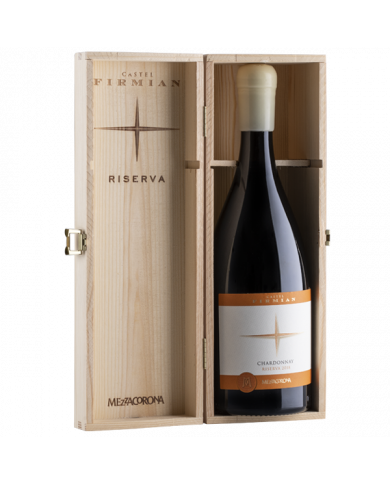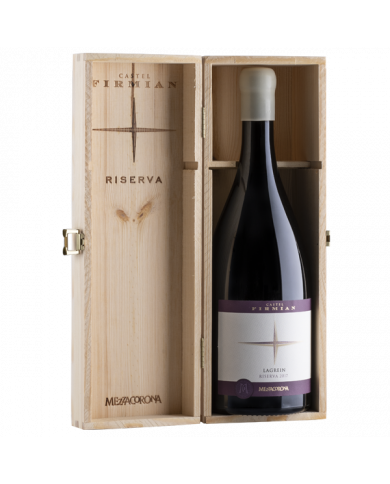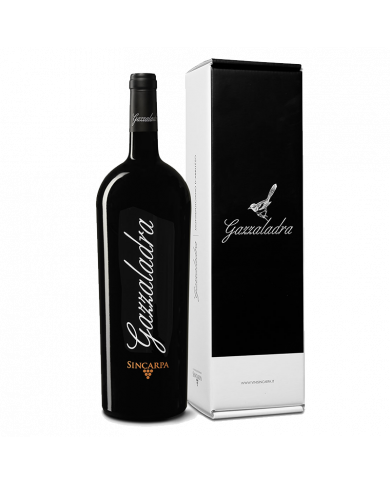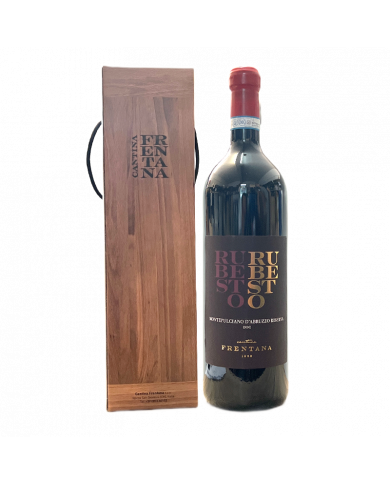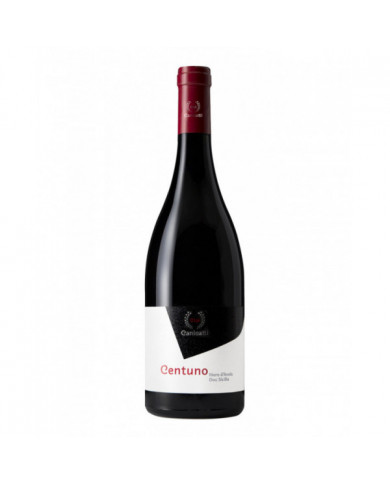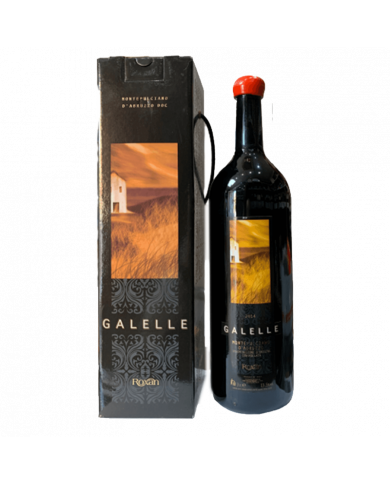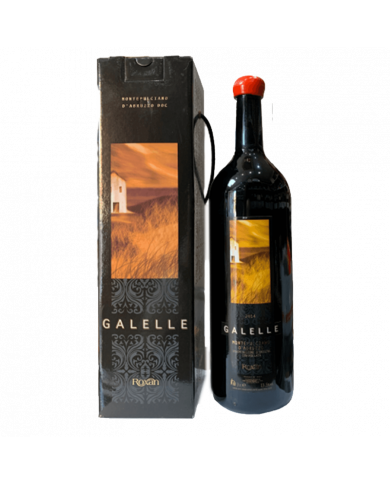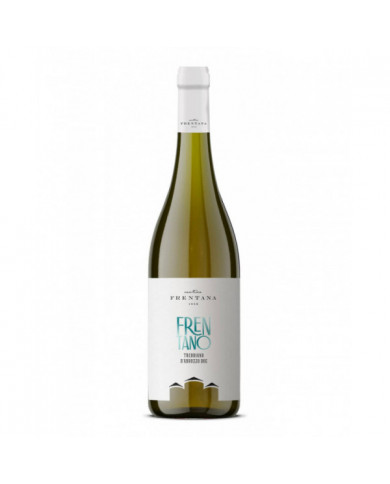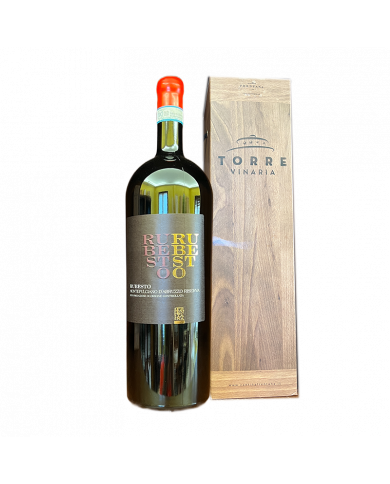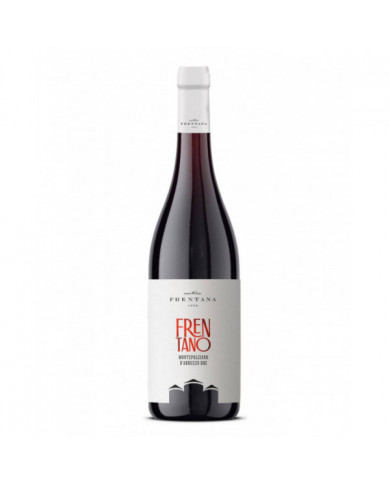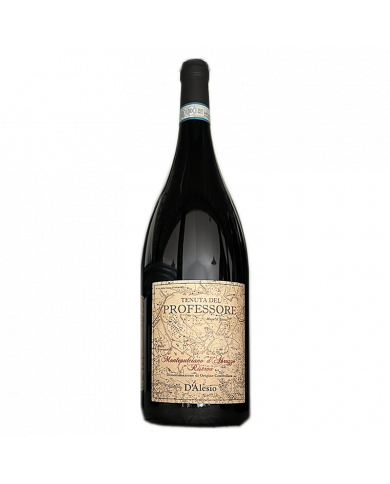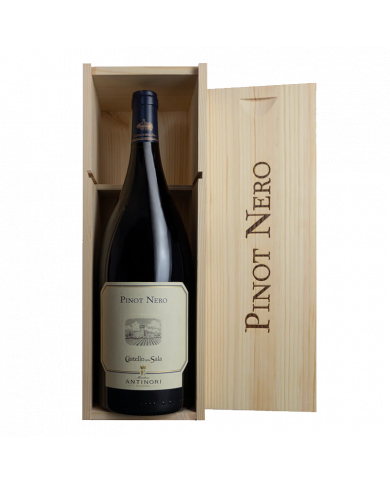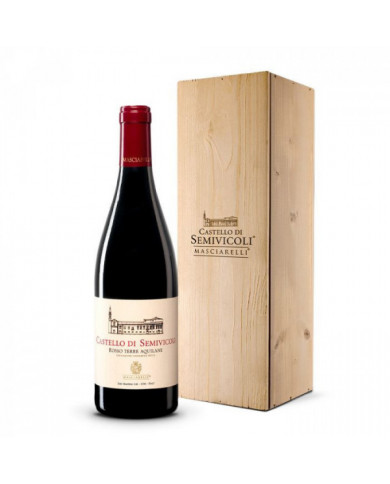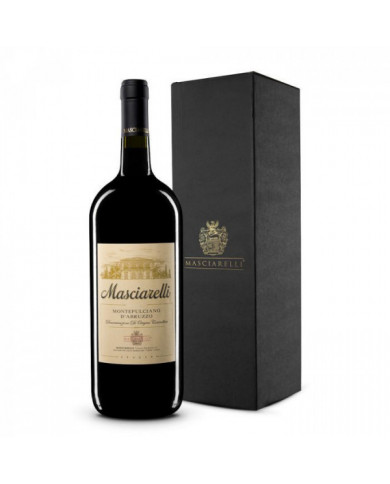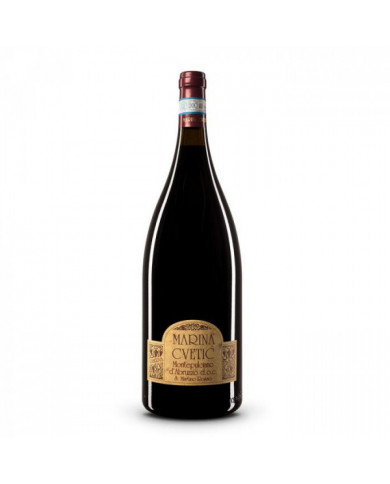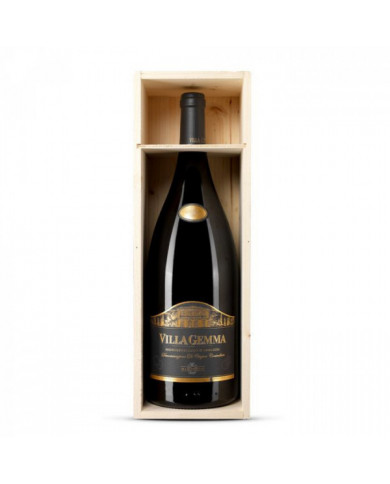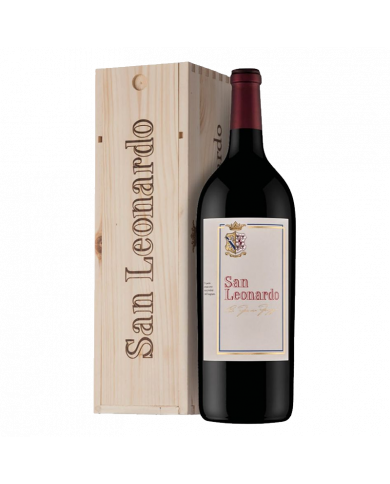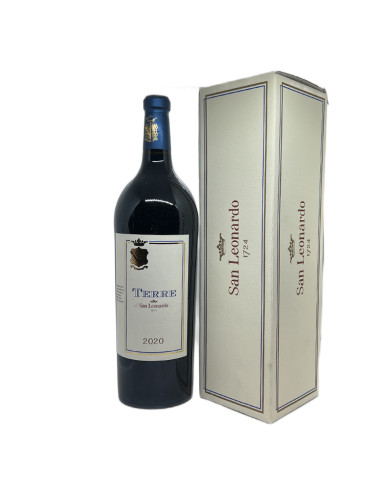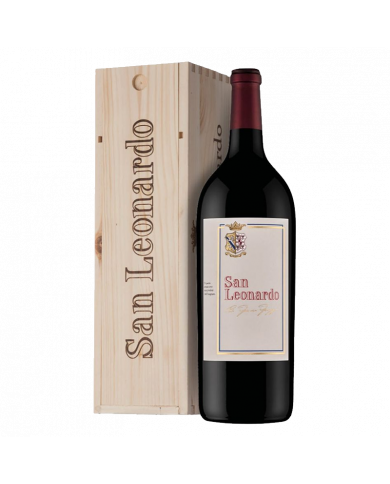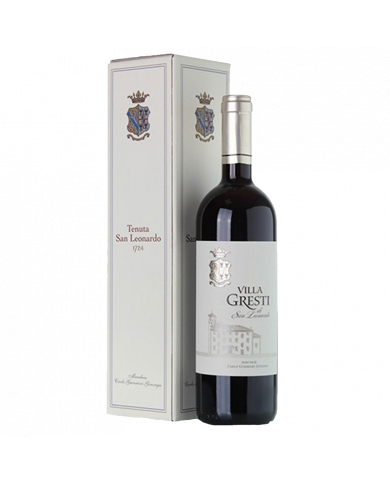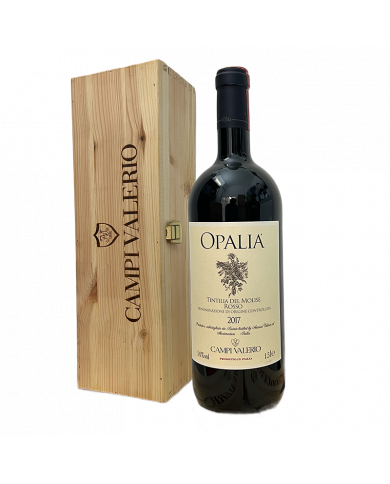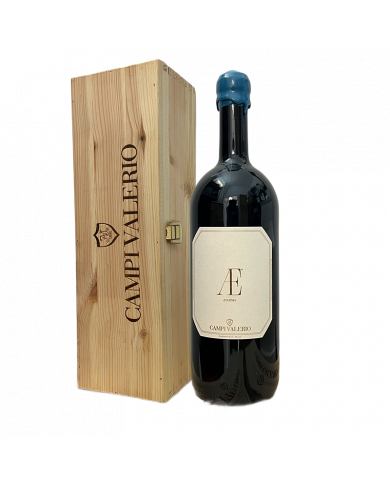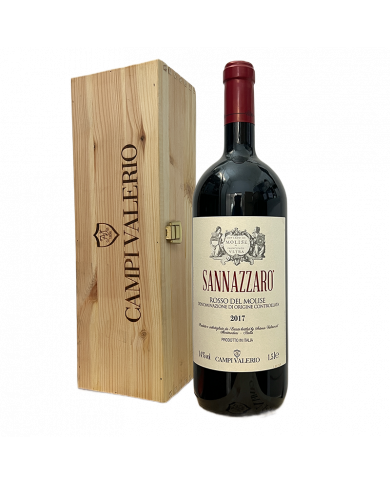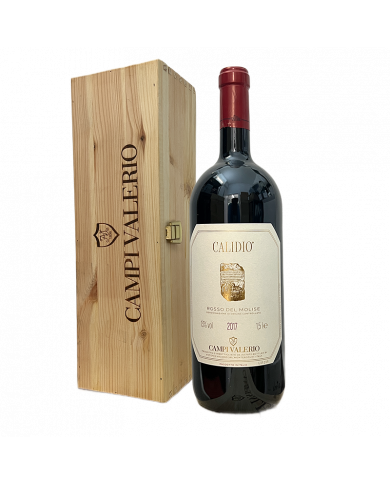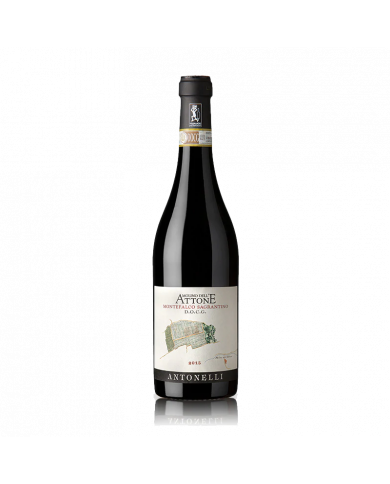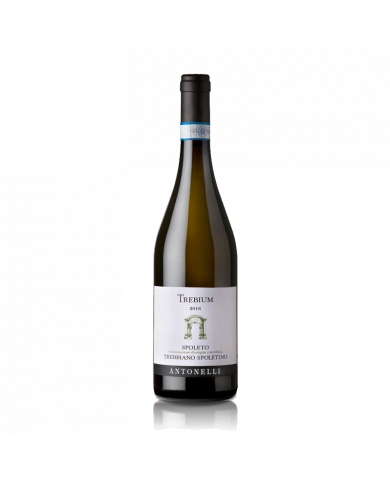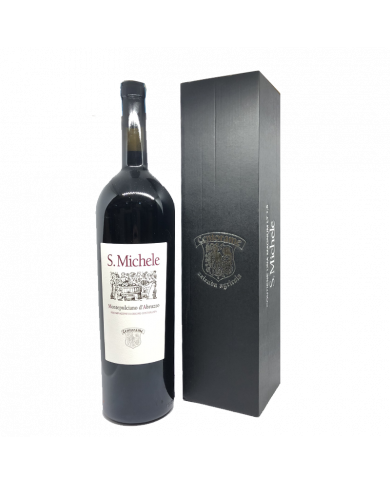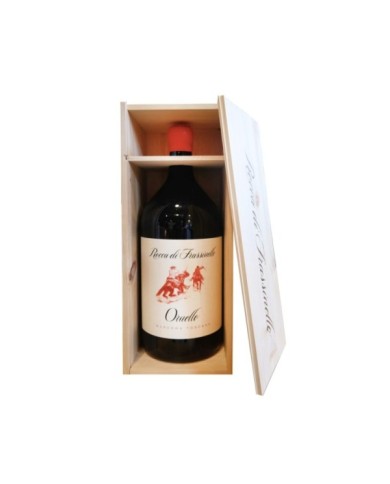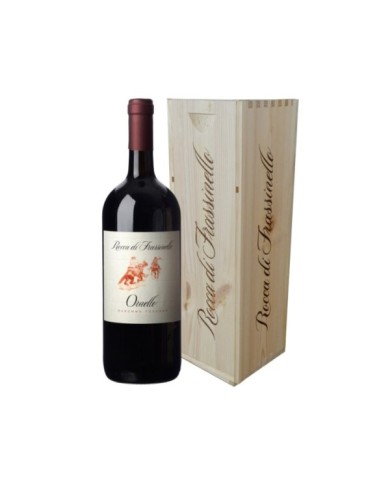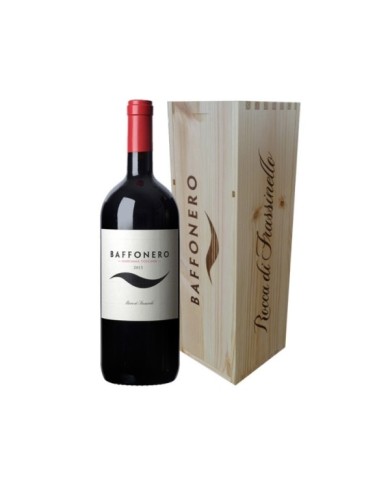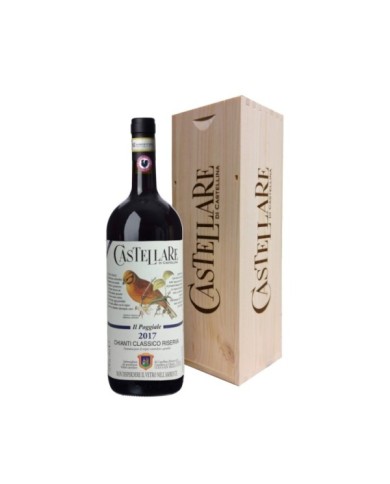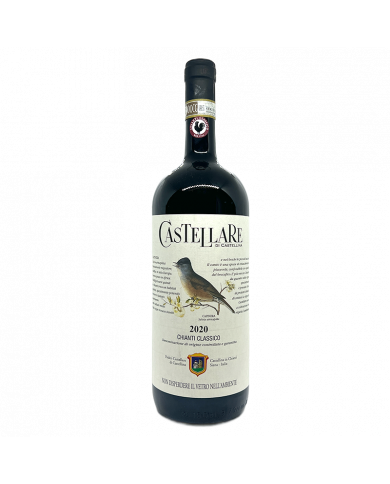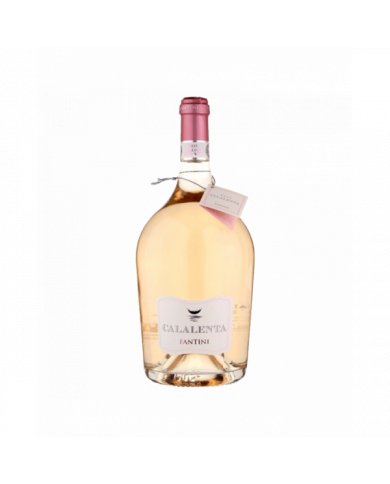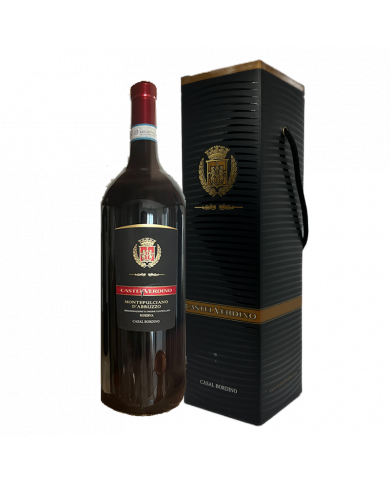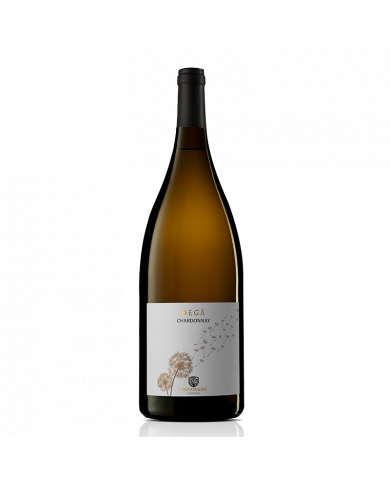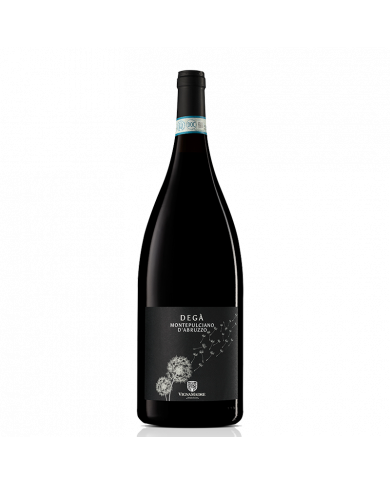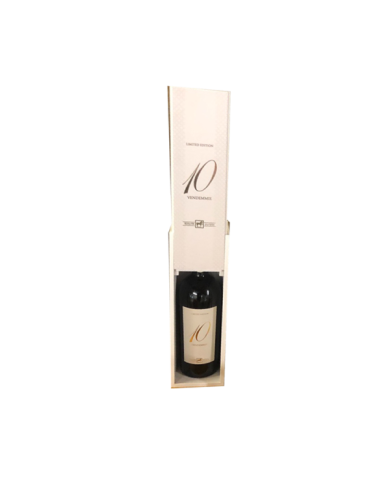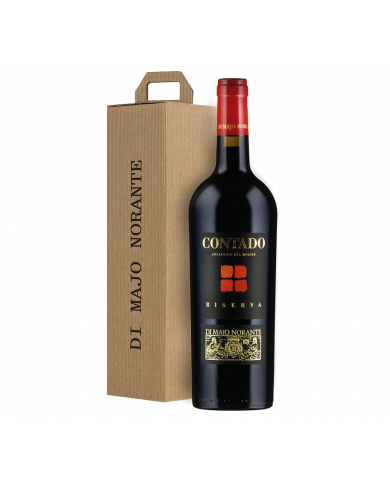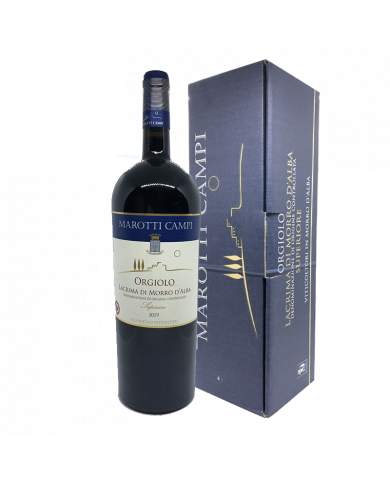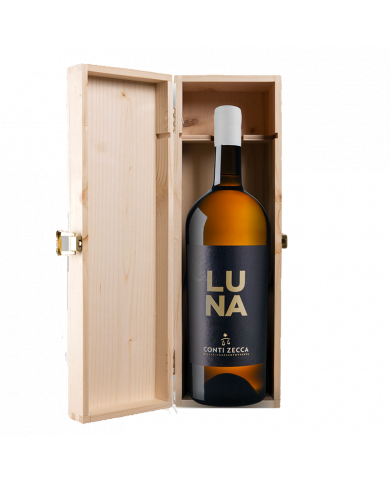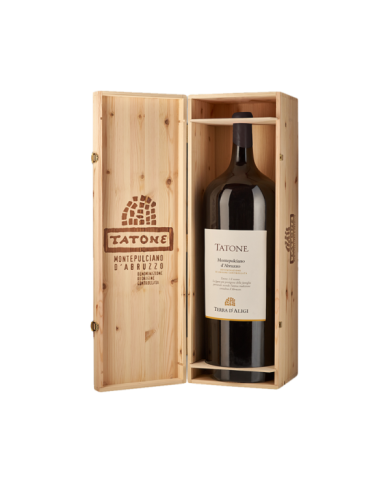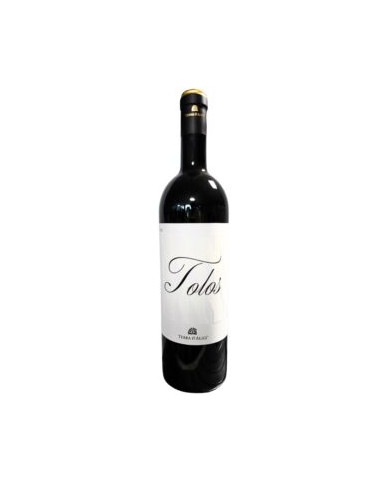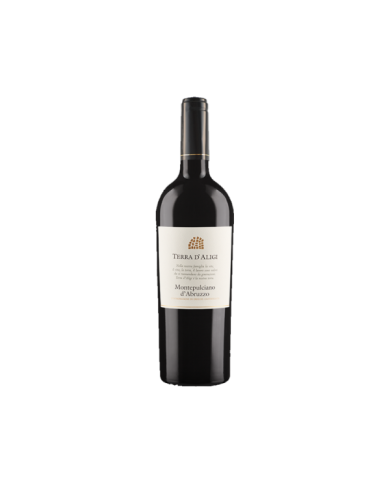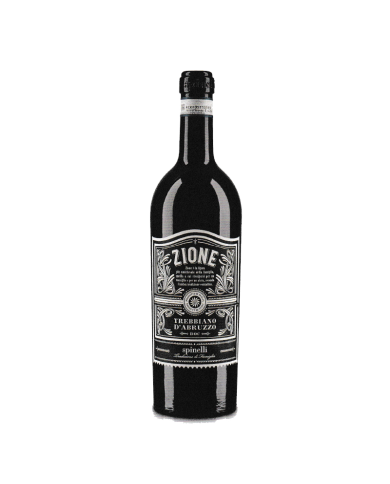The Rancia vineyard takes its name from the ancient farm that stands next to a pre-existing Benedictine monastery.
Versatile in food pairings, recommended with succulent and fatty meat dishes, elaborate first courses, sausages and local cured meats. The elegance and sumptuousness of this wine can also be combined at the end of a meal with mature cheese or dark bitter chocolate. Particularly important wine in our production, takes its name from the year in which Particularly important wine in our production, takes its name from the year in which the company was established, 1915 year of domination, when Francesco Spadafora, the company was established, 1915 annodomini, when Francesco Spadafora, four generations ago, began the adventure of our cellar. four generations ago the adventure of our cellar began.
The Montepulciano d'Abruzzo ŌĆ£Vigneto di Sant'EusanioŌĆØ is an intense, deep and concentrated red wine, vinified only in steel tanks and has good aging potential. It gives off earthy sensations of undergrowth, moss, roots, wild berry jam and red flowers. The sip is full-bodied, intense, very tasty and with robust tannins.
Serving temperature 18-20 ┬░ C. Serving suggestions It goes well with important meat courses such as roast, grilled and boiled meats; excellent with lamb.
1.5 liter bottle of our most award winning red accompanied by an elegant and lively metal case. Each family in Abruzzo has its own tatone. Confidential and affectionate appellation for the grandfather, the tatone actually represents a fundamental figure in the traditional family structure, to which age and maturity confer authority, prestige and wisdom.
Straw yellow with green reflections. The scent detects a wide range of fruits where white peaches and Williams pears prevail, followed by hints of lemon blossom and floral scents. When tasted it is noted for its rare pleasantness, where hints of fruit pulp are perceived.
Straw yellow with green reflections. The scent detects a wide range of fruits where white peaches and Williams pears prevail, followed by hints of lemon blossom and floral scents. When tasted it is noted for its rare pleasantness, where hints of fruit pulp are perceived.
The Grigio Gran Selezione, 80% Sangiovese enriched with ancient indigenous varieties such as Abrusco, Pugnitello, Black Malvasia, Ciliegiolo and Mazzese, is born only from our most suitable soils, which contribute to the complexity of the wine, keeping intact the elegance and expression of the terroir of San Felice .
The Grigio Gran Selezione, 80% Sangiovese enriched with ancient indigenous varieties such as Abrusco, Pugnitello, Black Malvasia, Ciliegiolo and Mazzese, is born only from our most suitable soils, which contribute to the complexity of the wine, keeping intact the elegance and expression of the terroir of San Felice .
Tradition and Future The first Supertuscan in Chianti Classico since 1968. It has an important history and today it stands out in the wine market of this category for a reason: it combines the tradition of international vines such as Cabernet and Merlot with the inclusion of a native variety, il Pugnitello, which is a unicum of San Felice .
This wine produced exclusively in Molise, in a limited edition in particular favorable vintages, unique for alcohol content, comes from a careful collection and manual selection in the vineyard of very ripe grapes grown at 550 meters above sea level It is obtained from the native grape of the region: the Tintilia , recently revalued variety. It is a fine and elegant wine that is best expressed with ŌĆ£importantŌĆØ dishes, braised meats, game, red meats, sausages and aged cheeses. Even drunk alone it is a worthy ending to an evening meal or it can be the companion of a pleasant meditation.
The color is deep, the bouquet is sensual and the body is vigorous. Wine whose refinement is appreciated when young, when fruit and spices blend with the taste of wood, in which Sagrantino has been elevated. But it is after a few years that its success is fully appreciated, when balsamic notes intervene and the tannins soften: thus we discover a wine with a great personality. Montefalco Sagrantino DOCG is suitable for long aging: 20 and more years. Rich in polyphenols which have antioxidant and therefore beneficial properties. The presence of deposits in the bottom of the bottle is natural. Sagrantino Di Montefalco Scacciadiavoli
That the Trebbiano Spoletino grape is of high enological interest is now a certain fact. It is an ancient vine that has only recently been rediscovered. It can be grown in the territory of Spoleto and Montefalco. In our cellar we have aimed to capture the finer and at the same time intriguing soul of this grape. We have given space to its changing and original aromas with a vinification in amphora that respects these characteristics and then we have strengthened its expressive character with an aging in untoasted wood and amphora for at least 9 months. In our opinion the result is that of a great white wine for aging, capable of surprising at every sip for its richness of facets.
We are at Morra, Serradenari, on soils from the Messinian period with a sandy loam texture with a strong presence of calcareous marl. At about 480m with a south-west exposure, the pure Nebbiolo grapes are vinified with spontaneous fermentation in truncated cone-shaped vats, macerating for about 40 days. The wine then ages for 30 months in 25-hectolitre Slavonian oak barrels.
Giulia Negri 's Barolo "La Tartufaia" is the producer's personal vision of the "La Morra" area who skilfully transforms the Nebbiolo grapes into an important and elegant red wine, with a deep and fine taste. On the nose the aromas are of red fruit, berries with notes of tobacco and licorice. On the palate it is full-bodied, enveloping with silky tannins and earthy and bloody sensations that close the sip.
Produced exclusively in the best vintages, it is an elegant wine, with great evolutionary potential, obtained from Montepulciano grapes. Each family in Abruzzo has its own LAL├ō. Confidential and affectionate name for the grandfather, the Lal├▓ actually represents a fundamental figure in the traditional family structure, to which age and maturity confer authority, prestige and wisdom. It is a mature, wise and virtuous red wine, as is a man with knowledge and experience of life.
Very intense ruby red colour. Intense and persistent bouquet, characteristic of the vine of origin with a note of good wood mixed with licorice and vanilla. Full and round taste on the palate thanks to its exceptional structure. Typical bitter almond aftertaste. It goes well with game, braised meats, red meats and roasts.
Intense ruby red wine with amaranth reflections. The nose presents captivating fruits of cherry jam and dates, notes of vanilla and licorice. The palate is marked by hints of small red fruits, juicy and ripe, and by the sweet nuances of wood. Warm and with a good fragrance, with gritty and pleasant tannins. Perfect as a meditation andŌĆ” conversation wine!
SPARKLING WINE OBTAINED WITH THE CLASSIC METHOD. REFERMENTATION TAKES PLACE IN THE BOTTLE FOR APPROXIMATELY 30 DAYS AT A TEMPERATURE OF 13┬░C, AFTER WHICH THE WINE AGES FOR 30 TO 40 MONTHS ON LEES OF YEAST. COMPLETELY MANUAL WORKING. STARTERS AND CAKES, BUT IT'S ALSO EXCELLENT FOR ALL MEALS.
Pathernus is a red wine that comes from grapes from the native Montepulciano d'Abruzzo vine. After a meticulous selection in the vineyard and aging in oak barrels, this red presents itself to the nose with a broad bouquet, structured on tones of dried flowers, red fruits and ethereal echoes. On the palate it is vigorous, supported by soft tannins and a long palatal memory
Chianti Classico Riserva is produced exclusively in the oldest wine-growing area of Tuscany, in a landscape of breathtaking beauty.
Chianti Classico Riserva is produced exclusively in the oldest wine-growing area of Tuscany, in a landscape of breathtaking beauty.
A Montepulciano d'Abruzzo Riserva with intense fruity aromas, with notes of black cherry and wild berries. Twenty-four months in oak barrels and six in the bottle for an aging that improves over time.
Nabui is one of the prestigious reds, together with Chio and Cavaliere Sardo, from the Cantina Sociale di Mogoro Il Nuraghe: a Monica di Sardegna DOC Superiore obtained exclusively from the native vine of the same name, whose name is a tribute to Neapolis, an ancient city Carthaginian not far from Mogoro, whose remains arise not far from some monica vineyards of the contributing members.
Cavaliere Sardo is the red that the Cantina Sociale di Mogoro Il Nuraghe wanted to dedicate to Leonardo Alagon, the last Marquis of Oristano, who in 1470 waged battle against the Aragonese militias by defeating them in the plain of Uras, the last heroic battle for the independence of Sardinia from the Aragonese crown before the definitive defeat, in 1478, in Macomer, where the Marquis was definitively defeated.
The hills of Fiego, from which the name Fiegorosso originates, are a micro-area of the Donnici sub-area of the PDO Terre di Cosenza, where Magliocco Dolce has always been grown. The particular exposure and the unique microclimate determine a characterization in terms of soil and climate and ampelography; the plants are the historical ones, cultivated with saplings, with very low average yields and manual harvesting.
Teroldego Rotaliano or 'Tiroler Gold' from a probable interpretation of the idiom 'Tiroler Gold' The rulers of Austria, during their regency in Trentino, considered this wine excellent both for its deep, intense colour, raspberry and blackberry fragrance and for its full, rounded flavour, rightly acid and free of tannins: precisely Tiroler Gold.
Born in 1989, the "Rosso Corleone" is perhaps among the first red wines that made Nero d'Avola known and appreciated in the world. Seductive, warm, full-bodied and professional wine. With an elegant and dry taste, it is a wine for the whole meal.
Born in 1989, the "Rosso Corleone" is perhaps among the first red wines that made Nero d'Avola known and appreciated in the world. Seductive, warm, full-bodied and professional wine. With an elegant and dry taste, it is a wine for the whole meal.
The wine has an intense ruby red color, a vinous and pleasant nose, with a hint of red berry fruit. Dry, soft, savory, rightly tannic flavor. It goes well with important first courses, red meats and aged cheeses. Serve at a temperature of 18-20 degrees 13.5% VOL
Li├╣ is a red wine produced from 100% Merlot grapes. It is inspired by principles of purity of variety, of slenderness and substance that comes from the young harvest still combined, however, with an expression of substance. The expansion and freshness of the soils, in fact, guarantee a gradual and progressive ripening of the grapes even in the hottest years and the rigor of good agronomic practices. The average production is 6000 bottles
Li├╣ is a red wine produced from 100% Merlot grapes. It is inspired by principles of purity of variety, of slenderness and substance that comes from the young harvest still combined, however, with an expression of substance. The expansion and freshness of the soils, in fact, guarantee a gradual and progressive ripening of the grapes even in the hottest years and the rigor of good agronomic practices. The average production is 6000 bottles
The vineyards are located in Castelnuovo Berardenga, in the south-eastern part of the Chianti Classico production area, north-east of Siena.
Power. A Franciacorta that expresses the strength of Pinot Noir combined with the elegance of Chardonnay and Pinot Blanc. Only a low dosage can bring out the full potential of this wine, ensuring great richness and complexity over time. A crescendo of aromas destined to surprise.
Fontalloro della Fattoria di Felsina is a Tuscan red wine based on Sangiovese, considered an unmistakable territorial brand. The complex aromatic profile is drawn by dark shades of blackberry, licorice and black pepper with light hints of tobacco. The body is powerful and structured, with well integrated tannins and a finish with a pleasant aftertaste.
The vineyards are located in Castelnuovo Berardenga, in the south-eastern part of the Chianti Classico production area, north-east of Siena.
The vineyards are located in Castelnuovo Berardenga, in the south-eastern part of the Chianti Classico production area, north-east of Siena.
The vineyards are located in Castelnuovo Berardenga, in the south-eastern part of the Chianti Classico production area, north-east of Siena.
Chianti Classico constitutes the company's production base. The vineyards are located in Castelnuovo Berardenga, in the south-eastern part of the Chianti Classico production area, north-east of Siena.
Chianti Classico constitutes the company's production base. The vineyards are located in Castelnuovo Berardenga, in the south-eastern part of the Chianti Classico production area, north-east of Siena.
Chianti Classico constitutes the company's production base. The vineyards are located in Castelnuovo Berardenga, in the south-eastern part of the Chianti Classico production area, north-east of Siena.
McCalin offers a very tannic red wine rich in acidity notes, which goes well with dishes based on red meat, game and sauces with long and complex preparations.
The ŌĆ£costetosteŌĆØ, the only Aglianico in Abruzzo, comes from our Le Coste vineyard: a very steep terrain completely exposed to the South. Extreme agronomic conditions for an equally extreme wine. Fierce tannins and exposed muscles make it an uncompromising red. You love it or you hate it. But it's easier to love him ...
This Riserva comes from the oldest vineyard in Fontefico, planted in 1970. The "titinge" is the fruit of our passion for authentic wine, an intense and elegant Montepulciano d'Abruzzo, with an incredible charge of colour. Its taste ŌĆ£tinglesŌĆØ your heart.
Montepulciano is the main grape of our region, the vine we love the most, the wine that, round and round, we drink with greater pleasure and in any circumstance. Montepulciano is our privileged grape, the one we pamper the most, it is Fontefico's ŌĆ£house coccaŌĆØ.
Cerasuolo d'Abruzzo is a unique wine of its kind, because it brings with it all the color and taste of the grape from which it comes. To those who ask us why we do not conform to the fashion of a more discreet and characterless ros├®, we answer: I was crazy! This is Fontefico's ŌĆ£fossimattoŌĆØ.
The Trento DOC Perl├® Ros├® Riserva from the Ferrari winery is a great Ros├® Millesimato obtained from a blend of Pinot Nero (80%) vinified in ros├® and Chardonnay (20%) whose maturation on the lees lasts 5 years before being bottled for a further rest period.
The Korem Magnum proposed by the famous Argiolas winery, an important family-run production company in southern Sardinia, is an Isola dei Nuraghi Typical Geographical Indication wine. A product of considerable interest, for a label that is a real pride of Sardinian oenology. This red is produced from the blend of Carignano, Bovale Sardo and Cannonau grapes, fruit of native varieties grown at 300 meters above sea level, on a medium-textured soil with the presence of clay and limestone.
Wine of excellent workmanship. Intense ruby red color, ample, elegant perfume with hints of cherry, soft and voluminous flavor. In the ancient tradition of the territory of Montefalco, after selecting the grapes for the production of Montefalco Sagrantino, all the other red varieties were harvested for the composition of a fresher and easy-to-match wine. Scacciadiavoli takes inspiration from this tradition and perfects it by adding that touch that makes this wine even more lovable.
Wine of excellent workmanship. Intense ruby red color, ample, elegant perfume with hints of cherry, soft and voluminous flavor. In the ancient tradition of the territory of Montefalco, after selecting the grapes for the production of Montefalco Sagrantino, all the other red varieties were harvested for the composition of a fresher and easy-to-match wine. Scacciadiavoli takes inspiration from this tradition and perfects it by adding that touch that makes this wine even more lovable.
Compact ruby red. The bouquet reveals the fragrance of red roses, black cherry, blood orange and blackberry. Followed by juniper berries, dried flowers, Tuscan cigars and undergrowth. The tannins are dense and silky which develop on a fresh and savory base. Persistent finish on blackcurrant echoes.
Compact ruby red. The bouquet reveals the fragrance of red roses, black cherry, blood orange and blackberry. Followed by juniper berries, dried flowers, Tuscan cigars and undergrowth. The tannins are dense and silky which develop on a fresh and savory base. Persistent finish on blackcurrant echoes.
Dark ruby red. The aromas let emerge hints of ripe berries, blood orange, maraschino cherries and aromatic herbs; fades into tones of licorice, black peppercorns and dark chocolate. The taste is full, enveloping and vigorous, with a very fine tannic texture. Persistent finish on flavors of rhubarb and myrtle.
Red is the color of passion. Strong, energetic, charged, exciting: our Montepulciano d'Abruzzo is exactly like that, enveloping and full-bodied. Each sip encourages the discovery of its sensorial complexity, but also to let oneself be pervaded by positive sensations and share them with those around us.
A magnificent wine envied by the whole world, a creation that only Antinori could obtain, the Chianti Classico Riserva, signed "Villa Antinori " is a true masterpiece of central Tuscany. We offer it in 3-liter format in its magnificent silk-screened wooden case. A perfect product for a gift or for an important dinner, destined to withstand even long aging, it is truly a wine not to be missed.
La Braccesca extends over 508 hectares where the ancient farm of the Bracci counts once stood, hence the name of the estate and its coat of arms: an arm covered with armor holding a sword. The total area of the vineyards is 340 hectares divided into two parts: the first, of 366 hectares of which 237 are planted with vineyards, is located on the border between the municipality of Montepulciano and that of Cortona. The other plot, 142 hectares of which 103 are vineyards, extends as far as Montepulciano between three of the most renowned sub-areas for the production of great red wines: Cervognano, Santa Pia and Gracciano. The first vintage of La Braccesca Vino Nobile di Montepulciano DOCG was 1990.
Cortona Syrah Achelo La Braccesca dei Marchesi Antinori was born in the homonymous estate, located on the Sienese hills. It is produced exclusively with Syrah grapes, harvested in mid-September. Fermentation takes place in stainless steel tanks at a controlled temperature of 28 ┬░ C for 10 days. Subsequently the wine partially ages in barriques and steel tanks for about 7 months, before being bottled.
Torcicoda di Tormaresca is a full-bodied, full and intense Primitivo, with clear aromas of berries, noble woods and coffee. The taste is consistent with the smell and reveals a good persistence. It is aged for 10 months in French and Hungarian oak barrels
Primitivo Neprica by Tormaresca Antinori is a puliese red wine from the province of Brindisi, aged in steel for about 8 months to maintain a fragrant and fruity sensorial profile. It has an intense ruby red color, furrowed by purple reflections, and releases notes of black cherries, small fresh and candied red fruits and licorice aromas to the nose, revealing a soft, round sip with evolved tannins, awakened by a balanced freshness .
ensational, enveloping, powerful and rustic, but at the same time capable of telling the story of the Salento area. The Sun, the beneficial influence of the sea and the wind. The classification is the classic one, Negroamaro IGT. Produced with 100% pure Negr or amaro grapes, conscientiously selected in the Maìme estate in S. Pietro Vernotico in Brindisi, where they are still raised as they once did in these areas, using the sapling and spurred cordon system.
Red wine of great impact with a bright color of intense hue. The nose is rich and concentrated with a fruity aroma well preserved in intensity and sweetness, where you feel the contact with the balanced and well-dosed wood. In the mouth it is enveloping, soft and round with a present but silky tannin. The characteristic acidic structure makes Badia a Passignano 2007 a pleasant wine of undoubted longevity, suitable for a long stay in the bottle.
Ruby red with light violet reflections in the glass, it presents itself to the nose with evident notes of ripe red fruit, jam and evident spiciness. Rich and satisfying on the palate, it combines an important body with a balanced flavor and tannic texture.
The history of Chardonnay di F├©lsina began in the eighties, from grafts of French clones in the vineyards owned by the nearby Tenuta di Farnetella.
The Rancia vineyard takes its name from the ancient farm that stands next to a pre-existing Benedictine monastery.
The grapes come from the Rancia Piccola and Poggiolo vineyards, the former also called del Maestro Raro, adjacent and with characteristics similar to that of Rancia.
The wine has a deep ruby red color with an intense aroma and fruity aromas, with notes of ripe red fruit as well as tertiary hints of green pepper, coffee, licorice and nutmeg. The warm, full-bodied, soft, tannic and long-lasting aromatic flavor is a real delight for the palate. To best enhance all its organoleptic characteristics, it is recommended to taste it in company and with grilled or braised red meats, cured meats and aged and flavored cheeses.
Stationmaster Montepulciano d'Abruzzo DOC Bio 2020, ruby red wine with violet reflections, the nose offers intense fruity aromas with notes of ripe red fruit. The flavor is full, soft and persistent with delicate tannins.
Red color with bright purple hues, intense and persistent undergrowth aromas, slightly astringent, important body.
Meditation wine, super structured, complex in aromas and body. Oxygenation is necessary: uncorking is recommended 4/5 hours before consumption.
Ruby, with garnet reflections. The nose is complex and characterized by aromas of small black berry fruits in jam and carob on a spicy background. The taste is powerful and harmonious, characterized by velvety tannins and a long and pleasantly balsamic finish.
Season was very regular, good rainfall until May, temperatures not very high; quite normal vintage
Dark ruby red. The aromas let emerge hints of ripe berries, blood orange, maraschino cherries and aromatic herbs; fades into tones of licorice, black peppercorns and dark chocolate. The taste is full, enveloping and vigorous, with a very fine tannic texture. Persistent finish on flavors of rhubarb and myrtle.
Bright ruby red. On the nose, hints of cherry, red currant, blood orange, peony and red roses alternate, on a background of cinnamon and cloves. The sip is enveloping, soft, with relaxed tannins, accompanied by an excellent freshness. Final on fruity references.
A Pinot Noir with a strong hint of fruit and a light and elegant woody note. A complex but very fresh red wine.
Le Difese is a full-bodied red wine with a Bordeaux style but with a Tuscan soul: a combination of Cabernet Sauvignon and Sangiovese, aged in barrique for 12 months. It is soft, round, elegant and velvety, animated by a balanced freshness and hints of cherries, chocolate, aromatic herbs and sweet spices
Guidalberto is an elegant and intense red wine, born from the desire to produce a younger wine than Sassicaia, also using Merlot grapes. After 15 months of aging in barrique it is expressed in a bouquet of berries, coffee, spices and Mediterranean scrub. On the palate it is fruity, full, solid and persistent.
The color is deep, the bouquet is sensual and the body is vigorous. Wine whose refinement is appreciated when young, when fruit and spices blend with the taste of wood, in which Sagrantino has been elevated. But it is after a few years that its success is fully appreciated, when balsamic notes intervene and the tannins soften: thus we discover a wine with a great personality. Montefalco Sagrantino DOCG is suitable for long aging: 20 and more years. Rich in polyphenols which have antioxidant and therefore beneficial properties. The presence of deposits in the bottom of the bottle is natural. Sagrantino Di Montefalco Scacciadiavoli
The wine production of Cantina Lunaria finds expression from the love and respect for an authentic land, from the desire to leave its pungent charm unchanged while making the most of its potential.
The grapes, after a careful selection, are de-stemmed and crushed, the skins are left in contact with the must with their indigenous yeasts for 10/15 days at a constant temperature of 25/28 ┬░ C. The refinement takes place partly in oak barrels and partly in stainless steel tanks for at least four months. Refinement in the bottle follows. At tasting it has an impenetrable ruby red color. Scent of red fruit and black cherry jam on everything, light notes of cocoa and toasting complete the bouquet. Warm taste, rightly tannic and therefore soft, intense, and with the typical almond finish. Ideal with cold cuts, grilled and baked meats, first courses with very structured sauces.
Intense and complex, at the first approach it is naturally expressed with ripe red fruit but then strikes for the intensity of the tertiaries: green pepper, coffee, licorice and nutmeg. A full-bodied and rightly tannic wine with a long persistence and great elegance. Maximum Expression: 8-10 years. Vinification: Permanence of 18 days on the skins with pumping over in the air, followed by static decantation in large barrels. The wine is aged for 12 months in barriques and then rests for 12 months in the bottle
Ruby red, the nose offers a complex and elegant olfactory profile. Notes of red fruit, cherry and morello cherry, blend well with hints of graphite, licorice and vanilla. A great complexity that opens to a long, enveloping, soft and balanced taste. A very dense tannic texture accompanies its development up to a finish of excellent persistence.
Hand painted label, oil on jute, by the painter Stefano Schiazza. Born in Milan in 1970, but raised in Pescara, Stefano Schiazza lives and works in Brecciarola di Chieti.
Hand painted label, oil on jute, by the painter Stefano Schiazza. Born in Milan in 1970, but raised in Pescara, Stefano Schiazza lives and works in Brecciarola di Chieti.
Obtained from the pure vinification of Montepulciano grapes. It is a young wine with a period of maturation in steel barrels of 6 months and a subsequent refinement of 4 months in the bottle. Intense ruby red color with marked floral and ripe fruit scents, it is a soft and balanced wine. 14.5% vol.
At tasting it has an intense and deep ruby red color with purple hues. Perfectly ripe and highly concentrated aromas. A mellow and harmonious fruitiness that offers hints of plum, date and fig. All fused with fine spicy notes. Pulpy and persuasive taste. It goes well with first courses with a good structure, roasts, stewed red meat, cold cuts and cheeses, including aged cheeses.
From the deep love of a family for their land and for wine, the sparkling wine Marramiero Brut is born. Particular dedication and profound experience accompany every moment of sparkling wine making. The process begins with the selection of Chardonnay and Pinot Noir grapes and continues with the choice of yeasts for refermentation in the bottle. The temperature control allows to prolong the fermentation and obtain a fine and persistent perlage.
Fermentation and long aging in small oak barrels are the peculiarity of this white wine, produced in limited quantities. Its aroma is broad and intense with hints of citrus and spice, its color is bright yellow. On the palate it is savory, balanced and with excellent structure and persistence. It can be best enjoyed when paired with dishes based on fish, seafood, shellfish, other dishes with delicate sauces and fresh and light cheeses.
After many years of experience with the Marramiero Brut and the maturation of the Pinot Nero vineyards, the passion has pushed us to compare ourselves with a classic Ros├® method. Only after a long and patient work and many months of permanence on the yeasts can we obtain those characteristics of excellence set for us to begin the marketing of our Ros├®.
It comes from particularly suitable areas of the Terre dei Vestini, where the low yields of grapes per hectare are not the result of any forcing: it is the soil itself that, by its nature, gives balance to the vineyard, ensuring that each cluster contains within itself a extraordinary concentration of quality. It is aged for 40 months: initially with fermentation and long maceration in Ganymede, then in stainless steel vats and subsequently in fine oak barriques to be completed with a permanence in the bottle of at least 6 months.
Hand painted label, oil on jute, by the painter Stefano Schiazza. Born in Milan in 1970, but raised in Pescara, Stefano Schiazza lives and works in Brecciarola di Chieti.
Cococciola is a rare native Abruzzo vine from the Frentana area, much appreciated for its quality and productivity. After a period of aging in steel at a controlled temperature, this white wine is made sparkling with the method called Martinotti or Charmat, which involves a double fermentation in an autoclave. The result is a Spumante Brut ideal to accompany your special occasions.
Only the best Sangiovese grapes selected in the company's Chianti Classico vineyards make up this Reserve, a valid combination of tradition and modernity. It ages for about 24 months in wood, of which a part (about 20%) in barriques, and one year in bottle. The label depicts a famous painting by Titian 'Man with armor'.
Historic vine and our workhorse. Strong and gentle in character and softness (as it is also said of the people of Abruzzo). Obtained from native grapes and selected in the harvest. Plant in rows 1/2 height exposed to solagna on calcareous-clayey soil. Appearance of cardinal red color with purplish reflections tending to blue. Excellent and well structured. Fruity and spicy bouquet, intense flavor and good body. Ideal with grilled red meats and more, salami and aged cheeses.
In the sunny Piana Rotaliana, along the banks of the Noce, fertile soils and favorable microclimates give rise to refined and fragrant grapes, from which Terre del Noce is born. Produced only with grapes from its own vineyards along the Adige Valley.
From the best Trentino sparkling wine tradition combined with the oenological style of Rotari , AlpeRegis Trentodoc is born, a special vintage dedicated to lovers of good food and good living. The name evokes the Royal figure of Rotari and a strong reference to the Alpine territory that has contributed to making Rotari legendary by fixing its deeds in history.
From the ancient philosophy of life that indicated the pursuit of pleasure as the ultimate goal, Hedonis was born: a wine that manages to satisfy the pleasure of the senses by celebrating the richness of Nero d'Avola in purity and embodying the most genuine and authentic expression of viticultural wealth and Sicilian winemaking. To create Hedonis, the B21 and B30 vineyards of Sambuca were selected, with a west-east orientation which favors direct radiation from the first light of the morning, immediately after the coldest moment of the day, causing a sort of thermal excursion limited directly on bunches and leaves. The rich and slightly clayey soils, the warm climate but with cool nights allow for perfect ripening of the grapes which are harvested around mid-September. A first part is subjected to fermentation and alcoholic maceration for about 15-18 days with repeated pumping over to extract the color and the tannic component. After malolactic fermentation, the wine is aged in new French and American oak barriques for 18-20 months. The second part of the grapes is instead subjected to drying in cells with temperature and humidity control for about 40-45 days until the loss of about 40% in weight. After fermentation and alcoholic maceration for about 15 days, the wine obtained from the withering is kept in steel for 18-20 months. At the end of the maturation period, 50% of the wine aged in barriques is combined with 50% of wine obtained from drying, creating a distinctive, rich and elegant aromatic union.
The Chardonnay Riserva comes from a selection of the best vineyards grown on the slopes of the Trentino mountains between 250 and 500 m above sea level. The preferred soils are of alluvial and draining origin. The grapes are harvested well ripe and characterized by a golden yellow colour, an indication of high aromatic richness. The skilful blending of wines obtained from vineyards located at various altitudes and with different exposures results in a wine that is ripe and rich but also fresh and fragrant. The grapes are harvested in September, partly subjected to cold maceration to increase the extraction of aromas and subsequently subjected to soft pressing. The must is fermented with the addition of selected yeasts, half in steel and half in lightly toasted French oak. The wines mature for 8 months in wood and 4 months in steel. The part that ages in barrique also carries out the malolactic fermentation and repeated batonage (resuspension of the fermentation yeasts) is carried out. Finally, 3-4 months of aging in the bottle follow.
The Teroldego vine is a native variety of Trentino and finds its ideal development environment in the Piana Rotaliana. The word "Teroldego" seems to derive from "Tiroler Gold" (gold of Tyrol), the name by which this wine was indicated at the Court of Vienna during the Austro-Hungarian empire; from this denomination ŌĆ£TiroldicoŌĆØ would later derive and later, Teroldego. Among the Trentino red wines it is the most renowned, so much so that it is defined as the "prince wine of Trentino". The Riserva di Teroldego is produced only in great vintages from carefully selected grapes by hand in the most suitable areas of the Piana Rotaliana: "Fron", "Rauti", "Camorzi" and "Sottodossi". The grapes are pressed with separation of the stems. The seeds are partially removed, followed by maceration on the skins with frequent pumping over and fermentation at a controlled temperature of around 25┬░C for 12-13 days. Minimum 24 months of maturation, of which 12 in precious oak wood (Allier and Troncais) followed by refinement in the bottle.
Autochthonous vine of Trentino Alto Adige, it has been cultivated in the Dolomite mountains since the fifteenth century where it has adapted perfectly. Over the centuries this vine has given rise to two different biotypes due to the different shape and size of the bunch: short bunch Lagrein and long bunch Lagrein. From the selection of the best short-cluster Lagrein vineyards grown along the Adige river valley, we produce this rich and powerful red. The Lagrein vineyards are grown on the hills at an altitude of 200-400m along the Adige river valley using only simple pergolas: this guarantees excellent exposure of the bunches to the sun, guaranteeing excellent aromatic and polyphenolic ripening without the risk of burning the grapes. When the grapes reach perfect ripeness, they are harvested and selected by hand around the second week of October. The grapes are vinified according to the classic red winemaking technique, at a temperature of 26┬░C for 12-13 days with the addition of selected yeasts. Maturation in wood follows for 10 months in French oak barriques with 3-year aging and light toasting. Finally, another 12 months of aging between steel and bottle are required.
it is obtained from a careful selection of the oldest vineyards of Montepulciano of our members who enjoy the best pedoclimatic conditions, capable of giving a more mature and structured wine. Fermentation with indigenous yeasts, with subsequent maturation and refinement in concrete tanks.
A Nero d'Avola, modern with its characteristic fruity notes and black pepper; harmonious, balanced, pleasantly tannic.
A Nero d'Avola with intense and persistent aromas that can be discovered for its modernity and charm. A classy wine, which surprises for its harmony and pleasantness, capable of revealing the authentic traits of the prince of Sicilian natives.
Ruby red in color, complex aroma with spicy notes and ripe fruit with a soft but decisive taste.
Ruby red in color, complex aroma with spicy notes and ripe fruit with a soft but decisive taste.
The term 'Trebbiano', according to its etymology, indicates a local village and home-made white wine that dates back to Etruscan and ancient Roman times. Today a large number of Abruzzo vines bear this name and give life to fresh and vibrant white wines. Trebbiano d'Abruzzo DOC Frentano perfectly reflects these characteristics and is excellent to accompany first courses of Mediterranean cuisine.
Farmers from the beginning of the 19th century. The D'Alesio farm, from 40 hectares of property on the Abruzzo hills of Citta Sant'Angelo, produces in organic farming: wine, extra virgin olive oil, legumes and selected cereals. SCIARR and D'ALESIO are the brands of excellence, selection and quality, respecting the territory and tradition. Result of the meeting of thoughts of three generations. The selection of their best grapes gives life to the D'ALESIO line, produced only in the most favorable years and in full respect of the natural cycles of the vine and wine.
Farmers from the beginning of the 19th century. The D'Alesio farm, from 40 hectares of property on the Abruzzo hills of Citta Sant'Angelo, produces in organic farming: wine, extra virgin olive oil, legumes and selected cereals. SCIARR and D'ALESIO are the brands of excellence, selection and quality, respecting the territory and tradition. Result of the meeting of thoughts of three generations. The selection of their best grapes gives life to the D'ALESIO line, produced only in the most favorable years and in full respect of the natural cycles of the vine and wine.
Produced since 1990 exclusively from Pinot Noir grapes, it is, in a certain sense, the "alter ego" of Cervaro: together they represent the two different expressions of the complex and refined soul of Castello della Sala. The 4 hectares of vineyards from which it is produced are located at over 400 meters above sea level on calcareous soils rich in fossils with sands of sedimentary origin dating back to the Pliocene.
The Chianti Classico Riserva "Villa Antinori " is a bursting expression of Tuscany and is aged for 24 months in wooden barrels. Complex, intense and rich on the nose. Elegant, full-bodied and structured on the palate. Here proposed in an elegant wooden box, ideal for a gift!
Wine symbol of the estate, it has its roots in its millenary history. A classic Bordeaux cut of aristocratic elegance and extraordinary longevity.
Terre, a classic Bordeaux blend, follows in the footsteps of the "older brother" San Leonardo , born from the same terroire, expresses great freshness and balance.
Wine symbol of the estate, it has its roots in its millenary history. A classic Bordeaux cut of aristocratic elegance and extraordinary longevity.
A refined blend of Merlot and Carm├©nere, Villa Gresti is a wine with a wonderful texture and velvety tannins.
Intense ruby red color. Hints of berries and licorice root on a vanilla base.
AE is a tribute to the city of Isernia. Ruby red color with violet reflections. the nose is complex and persistent with hints reminiscent of balsamic herbs and ripe red berries. Full-bodied, rightly tannic.
Intense ruby red. Intense bouquet with hints of black currant, black cherry, red fruits and ripe plums. Delicate notes of vanilla and vegetal nuances. Strong, warm on a soft and enveloping background. Sweet and round tannins in a body of excellent structure. Excellent balance and aromatic persistence.
Intense red. Wide bouquet reminiscent of wild violets, but also a scent of morello cherry with a pleasant herbaceous note. The taste is dry, acidulous and austere, rich in body. rightly tannic.
A cru that differs from our Chiusa di Pannone for the characteristics of the vineyard, facing east instead of south and with a richer soil in gravel.
The Sagrantino vine, cultivated for centuries exclusively in Montefalco, seems to have been brought there from Asia Minor by the followers of S. Francesco.
Trebbiano Spoletino is a typical variety of the territory that extends between Montefalco, Trevi and Spoleto; perhaps the name derives from ŌĆ£TrebiumŌĆØ, Trevi in Latin.
Purplish red in color with ruby reflections, it has a fresh and complex bouquet on the nose: roses, morello cherries, wild berries, fresh and rightly tannic on the palate, it is fruity again.
Intense ruby red. The nose expresses balsamic notes, hints of coffee and red fruit. On the palate it is soft and velvety, intense, warm and with excellent persistence.
For the whole meal, it goes well with meat dishes, including important roasts, cured meats and medium-aged cheeses.
Intense ruby red. The nose expresses balsamic notes, hints of coffee and red fruit. On the palate it is soft and velvety, intense, warm and with excellent persistence. For the whole meal, it goes well with meat dishes, including important roasts, cured meats and medium-aged cheeses.
Intense ruby red. The nose reveals notes of red fruit, in particular blackberry and blueberry, tobacco and vanilla. On the palate it is full, robust, outlined by a good freshness, of great persistence. Throughout the meal, it goes well with stewed red meats and game, excellent with spicy cheeses.
Intense and bright ruby red color to the eye. The nose is opened by the classic floral hints of violet, then followed by the fruity notes of plum, morello cherry and cherry, finally completed by a pleasant mineral nuance. The mouth continues on the path traced by the sense of smell, revealing itself to be typical, punctual and of excellent length.
Perfect to accompany red meat, it is ideal to be paired with the cut of Chianina.
The Chianti Classico of Castellare di Castellina is born in vineyards located in the municipality of Castellina in Chianti. It is produced with 95% Sangiovese grapes and 5% Canaiolo grapes, harvested in October. Fermentation takes place in stainless steel tanks at a controlled temperature of 28 ┬░ C for 15-20 days. Subsequently the wine is aged in barrique for 7 months, and for a further 7 months in the bottle. This Chianti Classico is characterized by a brilliant ruby red color with purple reflections. The nose opens with hints of cherries and violets, enriched by pleasant spicy notes of licorice and vanilla. On the palate it is balanced, with harmonious and delicate tannins. The wine has a finish that gives pleasant sweet sensations. Perfect to accompany cold cuts, first courses with meat sauce and roasts, it is ideal in combination with stews, game and aged cheeses.
1 Production area: South Coast of Abruzzo. Grapes and Vinification: Merlot. The grapes were harvested manually during the night to preserve their aromas and freshness. The grapes undergo a soft crushing-destemming, then the must is fermented in large steel tanks for 18/22 days at a low temperature (10/12 ┬░ C) to enhance the aromas. After a light and brief aging on the lees in steel tanks for 30/35 days, the wine is delicately clarified, filtered and ready to be bottled. Color and pairing: Ros├®, perfect with raw shellfish, vegetarian dishes, fresh cheeses, not too spicy Asian dishes and white meats.
Dishes based on red meats, game and aged cheeses. Also ideal for pleasant meditations.
The best of our grapes, our vines and our terroirs to obtain a dream wineŌĆ” All the passion and love for our land in a great wine that celebrates 10 splendid harvests respecting an ancient past. A wonderful fruit and an inimitable territory that create excellence.
The Contado is obtained from the vinification in purity of Aglianico grapes grown on the hills of Molise in the Camarda vineyard. Vinified in small steel fermenters with long maceration. The wine is aged for about three years, one of which in barriques and tonneaux.
Lacrima is a very particular vine, grown only in the terroir surrounding the municipality of Morro d'Alba. It is said that even Frederick Barbarossa appreciated it in the distant 1167 AD, when he settled in these territories to attack nearby Ancona. A strongly rooted grape, which the Marotti Campi company likes to decline in two versions: in particular this Lacrima Superiore DOC "Orgiolo" stands out for its precious olfactory bouquet, which, combined with an extremely pleasant drink, makes this bottle truly remarkable.
Large format wines are a popular choice for special occasions and for wine collectors. They come in different sizes and offer a variety of benefits over standard bottles. In this article, we'll explore everything there is to know about large format wines, from the benefits to storage and purchase.
The advantages of large format wines
Large format wines offer numerous advantages compared to standard bottles. Firstly, most wines in large formats age better than in standard bottles. This is because the amount of oxygen entering the bottle is less than in standard bottles. Additionally, the greater quantity of wine in a single container means that temperature fluctuations are less significant, reducing the risk of damage to the wine.
Secondly, large format wines are an ideal choice for special occasions. A large bottle quickly becomes the center of attention and makes an impression on guests. Also, one large bottle is much easier to handle than many smaller bottles. For example, if you're hosting a dinner party for a large group, you can use a few large bottles to make serving easier.
Dimensions of large format wines
Large format wines are available in different sizes, each with a specific name:
Magnum : 1.5 litres, equal to two standard bottles
Jeroboam : 3 litres, equal to four standard bottles
Rehoboam : 4.5 litres, equal to six standard bottles
Methuselah : 6 litres, equal to eight standard bottles
Salmanazar : 9 litres, equal to twelve standard bottles
Balthazar : 12 litres, equal to sixteen standard bottles
Nebuchadnezzar : 15 litres, equal to twenty standard bottles
Conservation of large format wines
The conservation of large format wines is an important aspect to consider. Because these bottles are larger than standard bottles, storing them can be trickier. Most wineries don't have shelves or spaces suitable for large bottles, so you need to plan ahead.
Also, large bottles may take longer to adjust to the ambient temperature in which they are stored. To avoid sudden changes in temperature, it is important to store large bottles in a cool, dry place.
Purchase of large format wines
Buying large format wines can be an excellent choice for wine collectors and for special occasions. However, it is important to pay attention to the origin of the bottles. Large bottles can be more susceptible to counterfeiting than standard bottles, so it's important to buy from reputable, reputable sellers.
What are wines in large formats?
Large format wines are bottles of wine that have a higher capacity than the classic 750 ml bottles. There are a number of larger wine bottle sizes including the Magnum (1.5 litres), Double Magnum (3 litres), Jeroboam (4.5 litres), Rehoboam (4.5 litres), Methuselah ( 6 litres), the Salmanazar (9 litres), the Balthazar (12 litres) and the Nebuchodonosor (15 litres).
Why choose wines in large formats?
There are many reasons to choose a bottle of wine in a larger format than the classic 750ml bottles. Firstly, wine in large formats has greater stability than standard bottles, thanks to the greater quantity of wine present in the bottle and the lower quantity of air that comes into contact with the wine.
Secondly, wines in large formats have a slower evolution, which means they can be kept for a longer period without undergoing any alteration. Furthermore, these wines have greater harmony and balance than standard bottles, thanks to the greater contact surface between the wine and the cork.
Finally, wines in large formats are ideal for special occasions, such as weddings, anniversaries, birthdays or corporate events, because they have a greater visual impact and are able to satisfy the palate of a greater number of people.
How to choose a large format wine?
Choosing a large format wine depends on the type of wine and personal needs. In general, the wines best suited to larger formats are those that require a longer aging period, such as structured red wines, complex white wines or sweet dessert wines.
Furthermore, it is important to choose a high quality wine, because the greater quantity of wine present in the bottle also increases the possibility that any defects will appear. It is therefore important to buy wines in large formats from reliable retailers who offer guarantees on the quality of the wine and its conservation.
Finally, it is important to consider the number of people who will participate in the event, in order to choose the right bottle format. For example, a bottle of Magnum (1.5 litres) is enough for around 10 people, while a bottle of Balthazar (12 litres) can cater for up to 100 people.
In conclusion, wines in large formats are an excellent choice for special occasions and for wine collectors, thanks to their greater stability, their ability to evolve more slowly and their ability to satisfy the palate of a greater number of people.

